Kobresia Willd., a genus of about 50 species (Willis, 1973; Dahlgren et al., 1985), and distributed in the northern Hemisphere, especially at high altitudes in the Himalaya, China and central Asia, belongs to the subfamily Caricoideae of the family Cyperaceae. The Caricoideae also includes genera such as Carex L., Schoenoxiphium Nees and Uncinia Pers. The Himalayan region contains the major diversity of Kobresia with about 30 species.
Kobresia is one of the important genera in the alpine flora of Nepal Himalaya (80°10'-88°10' E, 26°20'-30°20' N) and economically it is also an important pasture plant dominating a vast area of the alpine region where grazing animals feed on it extensively.
Boeckeler (1875), Clarke (1883, 1894, 1903, 1908) and Kükenthal (1903, 1909) were the pioneers who worked on Himalayan Kobresia. Clarke (1894) described 18 species of Kobresia from the Himalayan region in 'Flora of British India', including two species (K.fissiglumis and K. trinervis) from Nepal. Kükenthal (1909) in a worldwide monograph of Kobresia described 29 species, 21 of which were Himalayan, including five species from Nepal (K.fissiglumis, K. laxa, K. nepalensis, K. royleana and K. trinervis). After that there was a long gap in the study of Nepalese Kobresia until Ohwi and Koyama (1955) recorded Kobresia royleana from central Nepal. Koyama (1966) and Ohwi (1971) later listed five species of Kobresia from eastern Himalaya and Koyama (1973, 1975) listed 11 species from Nepal including a new species, K. williamsii. Malla et al. (1976 a, b), while commenting on two species (K. hookeri and K. pygmaea) from the Langtang area of central Nepal, gave a list of seven species in 'Catalogue of Nepalese Vascular Plants.' Koyama (1978) increased the number of species to 20 in 'An Enumeration of the Flowering Plants of Nepal.' Recently, Rajbhandari & Ohba (1987 a, b) described three new species, K. harae, K. mallae and K. esbirajbhandarii, from Nepal. There is no revisionary work of Kobresia from Nepal and the taxonomy is poorly understood. Therefore, a detailed study of the genus has been undertaken in order to make clear the species found in this area.
The present study shows that there is a need to revise Kobresia not only for Nepal, but worldwide. Schoenoxiphium, with about 15 species distributed in S Africa, Madagascar, C Asia and Sumatra (Willis, 1966), is closely related to Kobresia and also needs revision. These two genera are distinguished by the presence of a prominently elongated rachilla between the female and male flowers in the bisexual spikelets in Schoenoxiphium and the absence of such a structure in Kobresia. But some species of Kobresia, such as K. williamsii of Nepal and Tibet and K. clarkeana (Kükenthal) Kukenthal of the eastern Himalaya, show the development of such a rachilla. Koyama
(1961) considered Kobresia and Schoenoxiphium to be a single genus and transferred the species of Schoenoxiphium to Kobresia. Kern (1974) also commented that "it seems impossible to separate Schoenoxiphium from Kobresia on morphological grounds" and in his opinion the numerous attempts to distinguish between Schoenoxiphium and Kobresia in morphological terms "have completely failed." He transferred the only Malesian species of Schoenoxiphium, S. kobresioideum Kükenthal to Kobresia kobresioidea (Kükenthal) Kerm.
The present revision, based mainly on herbarium material, recognizes 23 species and one variety in Nepal Himalaya, including two new species and one new variety. Besides the Nepalese material we have also included other Himalayan specimens that were examined during this present study. During the botanical expeditions to central and eastern Nepal in 1983 and 1985, we had opportunities to collect a large number of specimens of Kobresia and to study them in their natural habitat.
The herbarium specimens preserved at the following herbaria were examined:
The Natural History Museum, London, Great Britain (BM),
Royal Botanic Gardens, Kew, Great Britain (K),
Department of Forestry and Plant Research, H.M.G. Nepal, Kathmandu, Nepal (KATH),
Merseyside County Museum, Liverpool, Great Britain (LIV),
Botanical Gardens and University Museum, University of Tokyo, Tokyo, Japan (TI),
National Science Museum, Tokyo, Japan (TNS).
Morphological Characters
The following morphological characters are used to distinguish the Nepalese species.
Inflorescence. The inflorescence is either branched with many spikes or is a simple spike. The inflorescence of K. royleana varies from branched with many spikes to single spiked. K. capillifolia C. B. Clarke of W Himalaya also shows such variation. In the other species this character is found to be stable.
Spikes. The spike is either unisexual consisting of all female or male spikelets, or androgynous consisting of female spikelets proximally and male spikelets distally. The shape of the spike can be linear, lanceolate, oblong or ovate.
Spikelets. The spikelet is either unisexual with only one kind of flower, or bisexual with a single proximal female flower and one to many distal male flower. Usually the androgynous spike consists of three kinds of spikelets, the lowest, the lateral and the terminal. The lowest spikelet in most cases is female. The terminal spikelet is male with few glumes. The lateral spikelets are either bisexual or unisexual and female.
Prophylls. The prophyll (or perigynium) is a characteristic structure in the Cari-coideae. It is clear from the work of Blaser (1944) that the prophyll of the Cyperaceae is modified leaf.
In Kobresia the margins of the prophyll open on one side (from the apex towards the base). The prophyll is either 2-nerved or without nerves. Two keels are found along the two nerves. The keels are either scabrid or smooth. The outer surface of the prophyll is smooth in all species examined except K. curticeps and K. uncinoi-des.
Sterile rachillas. The sterile rachillas in the female spikelets are absent to slightly elongated. In K. curvata, K. fragilis, K. laxa and K. uncinoides, however, the sterile rachillas are prominent and as long as or longer than the prophyll.
Flowers and Nutlets. The flower is unisexual in Kobresia. The female flower consists of a single pistil with a one-ovuled ovary and a single 3-fid style with three stigmas, except in K. macrantha, which has a 2-fid style and 2 stigmas. Male flowers occur in male spikes, in bisexual spikelets, and in androgynous spikes. Each male flower consists of three stamens boe in the axil of a glume.
The fruit is a trigonous nutlet in all species except K. macrantha where it is flattened. The nutlet is beaked or not beaked at the apex. K. macrantha and K. fissiglumis have distinctly stipitate nutlets. In the other species the nutlet is not stipitate.
Habit and Habitat. The species of Kobresia are perennial herbs from densely tufted or elongated rhizomes.
K. esbirajbhandarii and K. williamsii, which have loose and elongate rhizomes, usually dwell in shady or moist places; the other species of Kobresia dominate open, dry areas in the alpine region.
Culms. The culms of Kobresia are stiff, erect and trigonous. The culms of K. esbirajbhandarii, however, are slender and bent downward and those of K. curvata are curved.
Basal sheaths. Basal outer sheaths are either lamina-bearing or laminaless. They are either testaceous and hard, herbaceous and soft or membranous. K. mallae, which has testaceous basal sheaths can be distinguished by this character from its nearest ally K. trinervis, which has membranous basal sheaths.
Leaves. Two types of leaves are found in Kobresia, those with flat laminas and those with the laminas convolute or involute.
Taxonomic Treatment
Genus Kobresia Willdenow, Sp. Pl. 4: 205 (1805)-Bentham in Bentham & Hooker, Gen. Plant. 3: 1071 (1883)-C. B. Clarke in J. Linn. Soc. Bot. 20: 376 (1883); in Hook. f., Fl. Brit. Ind. 6: 694 (1894); in Kew Bull. Additional ser. 8: 136 (1908)-Kükenthal in Engler, Pfl.-reich IV-20, 38: 33 (1909) (as Cobresia).
Elyna Schrader, Fl. Germ. 1: 155 (1806).
Cobresia Persoon, Synops. Pl. 2: 534 (1807).
Hemicarex Bentham in J. Linn. Soc. 18: 367 (1881); in Bentham & Hooker, Gen. Plant. 3: 1072 (1883)-C. B. Clarke in J. Linn. Soc. Bot. 2: 382 (1883).
Perennial herbs. Rhizomes densely tufted or partly loose and elongated. Culms stiff and erect, sometimes slender and curved or bent, triquetrous or terete and striate, smooth. Basal outer sheaths testaceous, herbaceous or membranous, lamina-bearing or laminaless. Leaves shorter or longer than culms, usually arranged basally, sheaths and ligules membranous, flat and linear, convolute or involute, surfaces smooth, margins scabrid.
Inflorescences simple with a single spike or branched with many congested or loosely arranged spikes. Spikes unisexual or androgynous with female spikelets in the proximal and male spikelets in the distal parts. In the many-spiked inflorescence the lower spikes androgynous in each branch of the inflorescence and terminal male. Spikelets unisexual or bisexual. Bisexual spikelets with one female flower at proximal and one to four or five male flowers in the distal parts. Glumes of the lowest spikes ovate or oblong, aristate or not, sheathing at base or not, shorter than inflorescence, or sometimes leafy and longer than inflorescence. Glumes of the pistillate spikelets ovate, elliptic or oblong, membranous, 1-nerved, aristate or not. Prophylls elliptic, linear or ovate or obovoid, membranous, surface smooth or rarely hairy, 2-nerved or nerves indistinct, 2-keeled or sometimes keels obscure, keels scabrid or smooth; open on one side, margins connate at base, or sometimes free, or connate to just below the apex. Sterile rachillas in the female spikelets present and prominent or reduced and absent. Glumes of the male flowers of various shapes, membranous, smooth, 1-nerved. Male flowers with 3 stamens, filaments free, slender, longer than glumes. Ovary bi- or tri-carpellate with a solitary basal ovule. Styles 3-fid, or rarely 2-fid (K. macrantha). Stigmas 3 or 2. Nutlets trigonous or flattened (K. macrantha), beaked or not, sessile, or sometimes distinctly stipitate (K. fissiglumis, K. macrantha). Seeds trigonous.
Type species: Kobresia scirpina Willd. (= K. bellardii (All.) Degland).
The genusis named for Pauli de Cobres, a 19th century naturalist from Augsburg, Germany. Persoon (1807) adopted the spelling Cobresia. But, as it was originally spelled Kobresia and Willdenow did not correct it himself, the correct spelling should be Kobresia, as adopted here.
Key to the Species and Variety
1. Styles 2-fid, nutlet flattened………11) K. macrantha
1. Styles 3-fid, nutlet trigonous………2
2(1). Inflorescences simple consisting of a single terminal spike………3
2. Inflorescences compound with more than one spike………16
3(2). Spikelets unisexual………4
3. Lateral spikelets bisexual………12
4(3). Leaf blades filiform, convolute, up to 1 mm wide………5
4. Leaf blades flat, linear, 2-3 mm wide………7
5(4). Spikes 0.5-0.8 cm long; culms 1-6 cm high………15) K. pygmaea
5. Spikes 1-6 cm long; culms 8-60 cm high………6
6(5). Spikes 1-2 cm long, unisexual; prophylls obovoid, 3-4 mm long………22) K. vidua
6. Spikes 1.5-6 cm long, androgynous, or sometimes unisexual; prophylls linear-oblong, 4-7 mm long………13) K. nepalensis
7(4). Spikes androgynous 18) K. seticulmis
7. Spikes dioecious………8
8(7). Nutlets distinctly stipitate………5) K. fissiglumis
8. Nutlets not stipitate………9
9(8). Prophylls 2.8-4 mm long, keels scabrid, margins open from above clownn to the middle (sometimes below the middle but not up to the base)………10
9. Prophylls 2-2.8 mm long, keels smooth (or rarely minutely scabrid at basal part in K. mallae), margins open from above nearly to the base………11
10(9). Female spikes 3.5-6.5 cm long; rhizomes densely tufted, plants 8-26 cm high………20) K. trinervis
10. Female spikes 0.4-1 cm long; rhizomes tufted or obliquely elongated; plants 1.5-5 cm high………9) K. kanaii
11(9). Female spikes 0.7-1.5 cm long; culms slender and bent; basal outer sheaths membranous………4) K. eshirajbhandaril
11. Female spikes 2-3 cm long; culms erect; basal outer sheaths testaceous and shining………12) K. mallae
12(3). Spikelets 2-flowered (with one female and one male flower), or some of the upper spikelets becoming unisexual with abortive upper staminate flower………3) K. duthiei
12. Lateral spikelets 3- to 6-flowered (with one female and two or more male flowers)………13
13(12). Prophylls 1 mm long, shorter than nutlets………7) K. gandakiensis
13. Prophylls more than 3 mm long, longer than or equalling nutlets………14
14(13). Margins of prophylls open from above down to just below the apex………14) K. nitens
14. Margins of prophylls open from above down to below the middle or nearly to the base………15
15(14). Glumes of the bisexual spikelets elliptic; prophylls smooth, margins open from above down to the base………17) K. schoenoides
15. Glumes of the bisexual spikelets ovate; prophylls slightly scabrid, margins open from above down to below the middle………16b) K. royleana var. himalaica
16(2). Lateral spikelets bisexual; sterile rachillas of the female spikelets not prominently developed………17
16. Lateral spikelets unisexual; sterile rachillas of the female spikelets prominently developed, as long as or longer than the prophyll (in K. sikkimensis sterirachillas included in the prophyll)………20
17(16). Spikes densely arranged; prophylls oblong or obovoid………16a) K. royleana var. royleana
17. Spikes loosely arranged; prophylls linear or lanceolate………18
18(17). Surface of prophylls hairy; spikes 4-7 cm long………1) K. curticeps
18. Surface of prophylls glabrous; spikes up to 2 cm long………19
19(18), Prophylls 6.5-8 mm long, apex of the glume of bisexual spikelet rotundate-truncate………23) K. williamsii
19. Prophylls 3.2-4.2 mm long, apex of the glume of bisexual spikelet obtuse………8) K. harae
20(16). Spikes loosely arranged; sterile rachillas included in the prophyll………19) K. sikkimensis
20. Spikes densely arranged; sterile rachillas exserted from the prophylls or as long as prophyll………21
21(20). Surface of prophyll hairy………21) K. uncinoides
21. Surface of prophyll glabrous………22
22(21). Leaf blades flat, 2-3 mm wide; spikes linear-lanceolate………10)K. laxa
22. Leaf blades convolute or flat, 1.5-2 mm wide; spikes oblong or ovoid………23
23(22). Glumes reddish brown; inflorescence and the arista of the lowest glume straight………6) K. fragilis
23. Glumes yellowish brown; inflorescence and the arista of the lowest glume curved………2) K. curvata
1) Kobresia curticeps (C. B. Clarke) Kükenthal1) in Engler, Pfl.-reich IV-20, 38: 47 (1909)-T. Koyama in Ohashi, Fl. E. Himal. 3: 127 (1975)-in Hara et al., Enum. Fl. Pl. Nepal 1: 113 (1978). [Plate 63a; Figs. 1, 18]

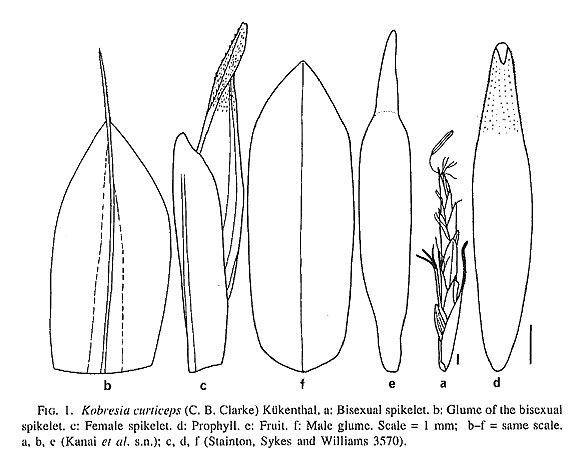

Carex curticeps C. B. Clarke in Hook. f., Fl. Brit. Ind. 6: 729 (1894); in Kew Bull. Additional ser. 8: 145 (1908).
Rhizomes tufted. Culms slender, often curved, 30-60 cm tall, 1-1.5 mm thick, triquetrous, scabrid, green; base covered with pale brown, lamina-bearing outersheaths. Leaves 16-32 cm long; lamina linear, flat, 3-5 mm wide, smooth, margin scabrid, midrib scabrid or not; sheaths membranous, pale brown; ligules 1.5-2 mm long, membranous, hyaline, pale brown.
Inflorescences linear, 2.5-12 cm long, 0.8 cm wide, with loosely arranged spikes; axis smooth. Glumes of the lowest spikes leafy with long arista, usually longer than the inflorescence. Spikes linear-lanceolate, up to 4.4 cm long, consisting of loosely arranged spikelets. Lowest spikelets bisexual, linear, up to 2 cm long, 3 mm broad, consisting of female flower at base accompanied by many male flowers, sometimes lowest spikelet female; lateral spikelets female, or sometimes lower lateral spikelets bisexual; terminal spikelets male. Glumes of the female spikelets ovate-oblong, aristate, 6.5-7.5 mm long excluding arista, glabrous, margin broadly hyaline; 1- nerved, nerve green; arista up to 6 mm long, scabrid. Prophylls linear-lanceolate, 8.5-9.5 mm long, membranous, pale green, 2-nerved, nerves scabrid, pubescent between nerves, margins open from above down to just below the apex. Sterile rachilla sometimes present in female spikelets and up to 0.7 mm long. Male glumes elliptic-lanceolate, aristate, 9 mm - 1.1 cm long excluding arista, glabrous, upper half reddish brown, lower greenish; 1-nerved; arista scabrid. Stamens 3; filaments slender, 1-1.3 cm long; anthers 4-4.2 mm long, yellow. Styles 3-fid, 2-3.5 mm long, base slightly swollen. Nutlets narrowly elliptic or oblong, slightly beaked, 6.5 mm - 1 cm long including beak, 1.2 mm broad in the broadest part, trigonous, smooth, yellowish brown, attenuate at base. Seeds oblong, 2 mm long, brown.
Distr.: E Himalaya (Nepal to Sikkim), Tibet.
Specimens examined. NEPAL: Above Sauwala Khola, 11500 ft. (Stainton, Sykes & Williams no. 3570, July 22, 1954, TI); Lamjung Himal, 11500 ft. (Stainton, Sykes & Williams no. 6375. July 16, 1954, BM); Thudam, 3400 m (Kanai et al. s.n., June 25, 1972, TI); Arun valley, Thudam, E of Chamtang, 12000 ft. (Stainton no. 1004, July 15, 1956, TI). DARJEELING: Singalelah, 10000 ft. (Clarke no. 13369 A, Oct. 7, 1870, BM). SIKKIM: Sandakphoo, 11800 ft. (Clarke no. 35056, June 6, 1884, BM); Sandakphoo, 12000 ft. (Gamble no. 9496, K); Sandakphoo (Clarke no. 34985, K-syntype); Tsomgo, 12000 ft. (Bor & Kiratram no. 19907, K); Lungthung, 12000 ft. (Bor & Kiratram no. 19837, K); Kyanglasha, 9000 ft. (Bor's collector no. 715, K); NE Sikkim (Cummins s.n., K). TIBET: Chumbi valley, 13500 ft. (Bor & Kiratram no. 20576, K).
Kobresia curticeps is characterized by the relatively large inflorescence with loosely arranged spikes, glumes of the lowest spikes leafy with long arista, and large pubescent prophylls. This species resembles K. williamsii T. Koyama but is distinguished from it by the presence of hairy prophylls. The hairy prophyll is also found in K. uncinoides (Boott) C. B. Clarke, but in K. uncinoides the female spikelet has a distinct, sterile rachilla as long as or longer than the prophyll. No such rachilla is found in K. curticeps.no. 20576, K).
2) Kobresia curvata C. B. Clarke in Kew Bull. Additional ser. 8: 68 & 137 (1908)-Kükenthal in Engler, Pfl.-reich IV-20, 38: 48 (1909)-T. Koyama in Ohashi, Fl. E. Himal. 3: 128 (1975)-in Hara et al., Enum. Fl. Pl. Nepal 1: 113 (1978). [Plate 63b; Figs. 2a-e, 19]

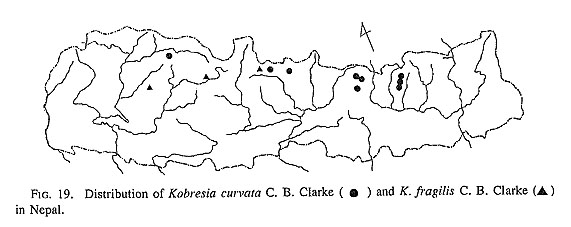
Carex curvata Boott, Illustr. Carex 1: 2, t. 5 (1858)-C. B. Clarke in Hook. f., Fl. Brit. Ind. 6: 728 (1894); non Knaf (1847).
Rhizomes tufted. Culms 1.5-36 cm tall, 0.8 mm thick, slender, curved, striated, smooth; base covered with pale-brown, lamina-bearing outer sheaths. Leaves 2-16 cm long; lamina filiform, convolute, rarely linear and flat, up to 2 mm wide, curved,
glabrous, margin scabrous, sheaths membranous, pale brown; ligules membranous,pale green.
Inflorescences linear or linear-oblong, 1.5-8 cm long, 0.5 cm wide, curved; with loosely arranged 3-7 spikes or sometimes spikes densely arranged; axis triquetrous, smooth. Glumes of the lowest spikes leafy, longer than the inflorescence, ovate-oblong, long aristate, 3.5-4 mm long excluding arista, (arista up to 8 cm long and curved). Spikes oblong or ovoid, 0.4-1 cm long, 3 mm broad, consisting of 1-4 female and terminal male spikelets; axis triquetrous, smooth. Female spikelets elliptic, 3 mm long. Glumes of the female spikelet ovate-oblong, apex obtuse or oblique or sometimes shortly aristate, 2.5-3.5 mm long excluding arista, 1.5 mm wide, glabrous, margin pale-green; 1-nerved, nerve green; arista scabrid. Prophylls elliptic-lanceolate, 2.7-3.5 mm long, smooth, green, margins open from above down to just below the apex; 2-nerved; upper half of the prophyll slightly curved. Sterile rachillas of the female spikelets linear, up to 3 mm long, as long as or longer than the prophyll, sometimes included in prophyll, green, 2-nerved, margin scabrid. Male glumes ovate, obtuse, 2.7 mm long, 1-nerved, glabrous, pale-yellow. Stamens 3; filaments slender, 2-3 mm long; anthers 0.6 mm long, yellow. Styles 3-fid, 0.5-0.6 mm long. Nutlets elliptic-ovoid, 1.5-2 mm long, 0.5-1 mm broad, trigonous, smooth, reddish brown. Seeds oblong, 1.2-1.6 mm long, yellowish brown.
Distr.: E Himalaya (Nepal to Sikkim), Tibet.
Specimens examined. NEPAL: Rambrong, Lamjung Himal, 12000 ft. (Stainton, Sykes & Williams no. 6020, June 29, 1954, BM, TI); Langtang - Kyanging, 3400-3800 m (Kanai & Shakya no. 672509, TI); Mul Kharka - Yatumbal, 3800-2700 m (Kanai & Shakya s.n., July 7, 1970, TI); Kyanging, Langtang Khola, 3600-3900 m (Kanai & Shakya no. 672594, July 15, 1970, TI); Yatumbal - Oo Kharka, 2700-3400 m (Kanai & Shakya no. 672163, TI); Oo Kharka - Mul Kharka, 3700 m (Kanai & Shakya no. 674728, July 1, 1970, TI); Janakpur Zone, Ramechhap District, Serdingma - Dubikharka, 3400-3720 m (Ohba et al. no. 8570250, July 7, 1985, TI, KATH); Dubikharka - Baula Pokhari, 3720-3960 m (Ohba et al. no. 8570311, July 9, 1985, TI, KATH); Botase Kharka - Koshing Kharka, 4000 m (Ohba et al. no. 8570600, July 21, 1985, TI, KATH); Thudam, 3400 m (Kanai et al. s.n., June 25, 1972, TI). SIKKIM: Sikkim, 12000-13000 ft. (Hooker f. s.n., BM); Kopup, 13000 ft. (Bor's collector nos. 462 and 529, K); Karponang, 8500 ft. (Bor's collector nos. 45, 694, K); Nathula, 14000 ft. (Bor's collector no. 476, K); Tsomgo, 12000 ft. (Bor's collector no. 593, K); Kyanglasha, 9000 ft. (Bor's collector no. 695, K); Deosa, 14000 ft. (Bor's collector no. 867, K).
Kobresia curvata resembles K.fragilis C. B. Clarke. The type specimen was not available, but we checked specimens of these two species preserved at BM, KATH, K, and TI and found that there was very little difference between them. The habit of the plants and the size, shape and texture of the nutlets of both species were similar. The surface microstructure of the nutlets of these two species are also similar (Rajbhandari & Ohba, 1988). Clarke (1903) and Kükenthal (1909) noted that some of the spikelets of K. fragilis were bisexual while those of K. curvata were all female, but, in the specimens of K. fragilis examined by us contained only unisexual spikelets. We did not notice any other differences between these two species except that both the inflorescence and arista of the lowest glume of K. curvata are curved whereas those of K. fragilis are straight. The inflorescence of K. curvata is long and lax while that of K. fragilis is narrow and congested. The glumes of the female spikelets in K. curvata are green, but those in K. fragilis are reddish brown.
In having a prominently developed sterile rachilla in the female spikelets K. curvata also resembles K. laxa Nees, from which it can be distinguished by its convolute leaves and oblong or ovate spikes.
3) Kobresia duthiei C, B. Clarke in Hook. f., Fl. Brit. Ind. 6: 697 (1894); in Kew Bull. Additional ser. 8: 137 (1908)-Kükenthal in Engler, Pfl.-reich IV-20, 38: 38 (1909)-T. Koyama in Ohashi, Pl. E. Himal. 3: 128 (1975); in Hara et al., Enum. Fl. Pl. Nepal 1: 113 (1978). [Plate 64a; Figs. 2f-k, 20]
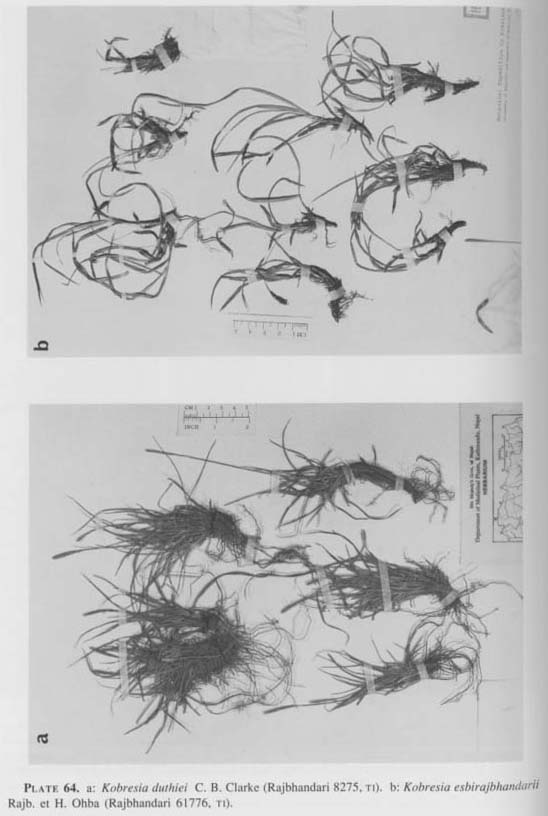

Rhizomes densely tufted. Culms 0.5-40 cm tall, 1 mm thick, erect, smooth; base covered with brown, lamina-bearing outer sheath. Leaves 1-16 cm long; lamina linear, flat, up to 2 mm wide, surface glabrous, margin scabrellate; sheaths membranous, smooth, palegreen; ligules minute, membranous.
Inflorescences erect, consisting of a single spike. Spikes linear or linear-oblong, 1-5 cm long, 2-3 mm wide, with many closely arranged spikelets. Spikelets ovate, 2.5-4.5 mm long, bisexual and 2-flowered, with basal female and upper male flowers, sometimes male flower reduced in some of the spikelets becoming unisexual. Glumes of the bisexual spikelets ovate, acute, obtuse or aristate, 2-4 mm long
excluding arista, 1.5-2 mm wide, glabrous, margin hyaline; 1-nerved, nerve green; apical part and arista scabrid, sometimes nerve also scabrid. Prophylls 2.2-4.5 mm long, oblong or linear-oblong, membranous, nerveless, smooth, pale green or sometimes partly brown, 2-keeled, keels scabrid, margins open from above down to the middle. Male glumes elliptic, obtuse, 2.2-4.5 mm long, glabrous, 1-nerved or nerveless. Stamens 3; filaments slender, 2-3 mm long; anthers 0.8-1.2 mm long. Styles 3-fid, linear, 0.5 mm long. Nutlets obovoid-oblong, short beaked, 3.5 mm long including beak, trigonous, smooth, pale yellow. Seeds oblong, obtuse, 2 mm long, 0.6 mm broad, greenishyellow, apical portion brown.
Distr.: Himalaya (Punjab to Sikkim), Tibet.
Specimens examined. PUNJAB: Above Inanali (Drummond no. 24142, K). KUMAUN: Palang Gadh, Byans, 11000-12000 ft. (Duthie nos. 6093, 6094, BM-isosyntypes); Nipechong Valley, 14000-15000 ft. (Duthie no. 3461, BM-isosyntype). NEPAL: Dojam Khola, near Suli Gad, 14000 ft. (Polunin, Sykes & Williams no. 2277, June 21, 1952, TI); Maharigaon, 3 miles NE, ca 14500 ft. (Polunin, Sykes & Williams no. 133, July 13, 1952, BM,TI); Bhurchula Lekh, near Jumla, 12000 ft. (Polunin, Sykes & Williams no. 4507, July 10, 1952, BM, TI); Thorungse Phedi, Mustang Distr., 4050 m (Rajbhandari no. 8275, July 24, 1983, TI, KATH); Below Marpha Peak, Dhaulagiri Himal. 15000-16000 ft. (Jones no. V-30, Sept. 5-Oct. 15, 1980, BM); Hidden Valley, Dhaulagiri Himal, 5065 m (Wald no. 52, Sept. 5-Oct. 15, 1980, BM); Cha Lungpa, 13500 ft. (Miehe nos. 380, 386, July 29, 1977, BM); Sabche Valley, Annapurna Himal, 4750 m (Wraber no. 36461, Oct. 8, 1969, BM); Mane - Thale Patil, 3500 m (Kanai & Malla no. 674754, Aug. 24, 1969, TI); Rukthang - Kuri, 3300-3250 m (Kanai, Shrestha & Adhikari no. 674656. Sept. 28, 1970, TI); Sabze Khola, 13000 ft. (Lowndes no. 1220, July 20, 1950, BM, TI); Dudh Kunda, Dolakha District, 4550 m (Rajbhandari no. 9963, Sept. 5, 1983, TI, KATH); Patio Pokhari - Phedi Kharka, Dolakha District, 3900 m (Rajbhandari no. 10246, Sept. 13, 1983, TI, KATH); Around Jata Pokhari, 4220 m (Ohba et al. no. 8590114, July 13, 1985, TI); Janakpur Zone, Ramechhap District, Thare Og - Thare Teng, 4000 m (Ohba et al. no. 60661, July 24, 1985, TI, KATH); Sagarmatha Zone, Solukhumbu Distr., below Dudh Kund - upper Dudh Kund Glacier, 4600 m (Rajbhandari no. 61769, Aug. 29, 1985, TI, KATH); Beni Kharka (Dambuk) - Lum Teng, 3970-4600 m (Wu no. 8581145, Aug. 24, 1985, TI, KATH). SIKKIM: Natula, 14000 ft. (Bor's collector no. 1038, K); Jelep La, 14000 ft. (Bor's collector nos. 850, 887, K).
Kobresia duthiei resembles K. bellardii (All.) Degland, a widely distributed arctic-alpine species, in having a single spike and bisexual 2-flowered spikelets, but it can readily be distinguished by the flat leaves and green spikelets. In K. bellardii the leaves are filiform and the spikelets are brown.
4) Kobresia esbirajbhandarii Rajb. et H. Ohba in J. Jap. Bot. 62: 259, f. 2I-N, 3B (1987). [Plate 64b; Figs. 3a-g, 21]
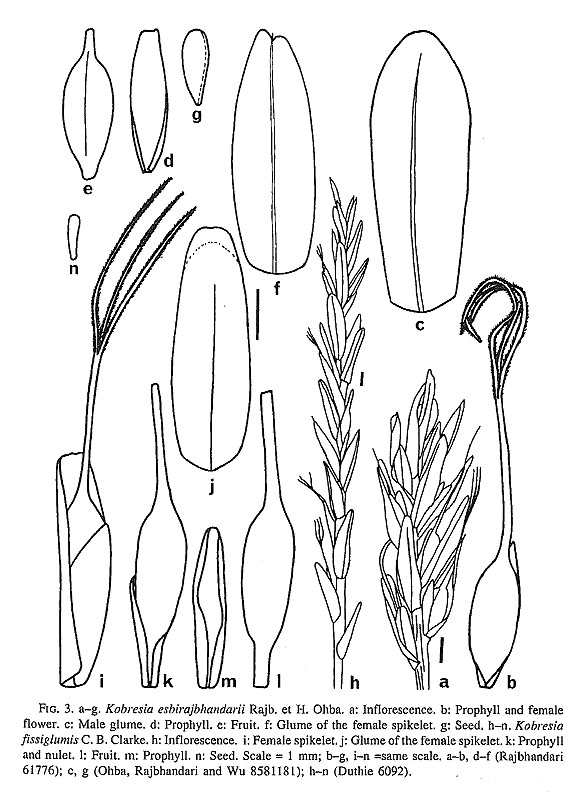

Rhizomes obliquely elongated, 1.5-2 mm thick, clothed with brown scales. Culms slender, bent down, 4-6 (up to 12) cm tall, 0.4 mm thick, smooth, greenish brown; base covered with greenish brown, membranous, 1.5-2 cm long, 2-3 mm broad, linear-oblong, lamina-bearing outer sheaths. Leaves longer than culms; lamina up to 10 cm long, linear-lanceolate, flat, 2-2.5 mm wide, smooth, margin scabrid; sheaths membranous, smooth; ligules small, membranous, smooth.
Inflorescences unisexual, consisting of a single spike; male spikes linear, 6-8 mm
long, 1.5 mm wide; female spikes linear or linear-oblong, 0.7-1.5 cm long, 2-4 mm wide, axis smooth, spikelets up to 12 in number. Glumes of the female spikelets, elliptic-oblong, 4-5 mm long, 1.5 mm wide, glabrous, apex obtuse, obliquely cut, or aristate, reddish brown, apical margin hyaline; 1-nerved; lowest glumes not sheathing. Prophylls oblong, 2-2.7 mm long, 0.6-0.75 mm broad, membranous, nerveless, smooth, brown, keels smooth, margins open from above down to the base. Male glumes 5-5.2 mm long, 0.8 mm wide, oblong, obtuse, glabrous, reddish brown, 1-nerved, apical part hyaline. Stamens 3; filaments slender, 4-5 mm long. Styles 3- fid, 1.5-3 mm long, base linear. Nutlets elliptic-oblong, 2 mm long, 4 mm broad, trigonous, smooth, reddish brown, slightly beaked. Seeds oblong-lanceolate, obtuse, 1.4 mm long, 0.5 mm broad, trigonous, reddish brown, base attenuate.
Distr.: Himalaya (Nepal).
Specimens examined. NEPAL: Janakpur Zone, Ramechhap Distr., Thare Og - Bigphera Lho Glacier, 4150-4700 m (Wakabayashi et al. no. 8580525, July 27, 1985, TI, KATH); Benikharka - Yurigolcha, 4400 m (Rajbhandari no. 61707, Aug. 23, 1985, TI, KATH); Sagarmatha Zone, Solukhumbu District, below Dudhkund - upper Dudhkund Glacier, 4600 m (Rajbhandari no. 61776, Aug. 26, 1985, n-holotype, KATH-isotype); Beni Kharka - below Dudh Kunda, 3970 -4450 m (Ohba, Rajbhandari & Wu no. 8581181, Aug. 26, 1985, TI, KATH).
Kobresia esbirajbhandarii grows on open rocky slopes of the alpine region, often with species of Festuca, Poa, Saxifraga, Rhodiola, Cortia, etc. This species resembles K. mallae Rajb. et H. Ohba found in central Nepal from which it can be easily distinguished by its shorter female spikes (0.7-1.5 cm long), membranous basal outer sheaths and bent culms.
5) Kobresia fissiglumis C. B. Clarke in Hook. f., Fl. Brit. Ind. 6: 696 (1894); in Kew Bull. Additional ser. 8: 137 (1908)-Kükenthal in Engler, Pfl.-reich IV-20, 38: 43 (1909). [Plate 65a; Figs. 3h-n, 22]

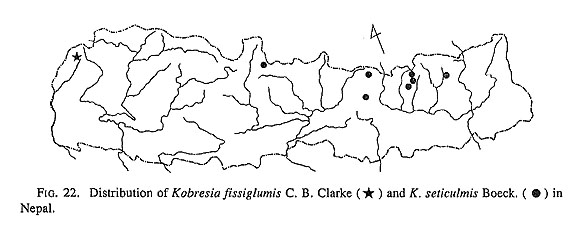
Dioecious. Rhizomes densely tufted. Culms 6-14 cm tall, slender, smooth, green, base covered with brown, laminaless outer sheaths. Leaves shorter than culms, 2- 11 cm long; lamina linear, acuminate, flat, up to 2 mm wide, surface glabrous, margin scabrid; sheaths membranous, glabrous, greenish yellow or greenish brown; ligules membranous, 1.5 mm long.
Inflorescences erect, consisting of a single spike. Spikes dioecious. Female spikes linear, 2,5-4 cm long, 2-3 mm wide. Upper spikelets densely arranged, lower loose. Male spikes linear, 1.5 cm long, 3 mm wide. Glumes of the female spikelets 4-5 mm long, 1.5 mm wide, oblong or oblong-lanceolate, apex roundish to obtuse, glabrous, reddish brown, 1-nerved, apical portion hyaline. Prophylls elliptic-oblong, 3 mm long, membranous, nerveless, 2-keeled, keels obscure, smooth, reddish brown, margins open from above down to the base. Male glumes oblong, apex roundish, 6-7 mm long, 2 mm broad, glabrous, reddish brown, 1-nerved. Stamens 3; filaments slender, 7-8 mm long; anthers 2.5-2.7 mm long. Styles 3-fid, slender, 2.5 mm long. Nutlets oblong, beaked, 4-5 mm long including beak, trigonous, stipitate, stipe 0.6 -0.7 mm long, surface smooth, greenish yellow, beak brown. Seeds oblong, obtuse, 0.9 mm long, greenish yellow.
Distr.: C Himalaya (W Nepal).
Specimen examined. W NEPAL: Nampa Gadh, 12000-13000 ft. (Duthie no. 6092, July 25, 1886, K-holotype).
Kobresia fissiglumis is an endemic and rare species of Nepal. The floral characters resemble those of Kobresia mallae Rajb. et H. Ohba of C Nepal, which is also a rare species. K. fissiglumis differs from K. mallae by the absence of testaceous, shining outer sheaths. The sheaths are characteristic in K. mallae. In K. fissiglumis the prophyll is longer and the nutlet is distinctly stipitate, and longer than in K. mallae. The floral characters of K. fissiglumis also resemble those of K. esbirajbhandarii Rajb. & H. Ohba, but the longer female spikes and the stipitate, longer nutlets readily distinguish it from the latter.
The habit of K. fissiglumis is similar to that of K. trinervis (Nees) Boeck., but the margins of the prophyll are open to the base in K. fissiglumis while in K. trinervis the margins are open to just below the apex or to the middle. The nutlet of K. fissiglumis is also stipitate. The type of K. fissiglumis is Duthie no. 6092 in Kew. Another Duthie's specimen in BM with the same number (6092) collected at Kumaun, Palang Gadh, Byans, 11000-12000 ft. has been annotated as "Hemicarex trinervis Benth. & Hook. f. forma? spicisnigrescentibus." In habit and nature of the inflorescence this specimen resembles K. trinervis. The margins of the prophyll open only to just below the apex; the nutlet is not stipitate. Since the characters all match we therefore considered this specimen to be K. trinervis.
Clarke (1894) cited Duthie no. 6092 and said that the specimens were all female, but we found a male spike on the type specimen with the same number preserved at K.
In a packet of specimens of Kobresia sent to us on loan from Kew we found an interesting specimen of Kobresia which was collected by J. S, Gamble at Tehri Garhwal, India, 10000 ft. (Gamble no. 26853, May 1898). This specimen has an inflorescence composed of a single unbranched spike and unisexual spikelet, and resembles K. seticulmis Boeck. and K. fissigiummis, but differs from the former in having distinctly stipitate nutlet and from the latter in having prophylls with margins opening to the middle and scabrid keels. The nutlet of K. seticulmis is not stipitate and the prophyll of K. fissiglumis is smooth with the margins open to the base. The specimen has only fruits and the stigmas have all fallen, but the trigonous shape of the nutlet indicates that the number of stigmas may be three. No other specimen similar to this is available for study, but when others similar to this have been collected and the diagnostic characters determined, this specimen may be a new taxon. Since the specimen resembles both K. fissiglumis and K. seticulmis a comparison of some of the characters of these is given in Table 1.
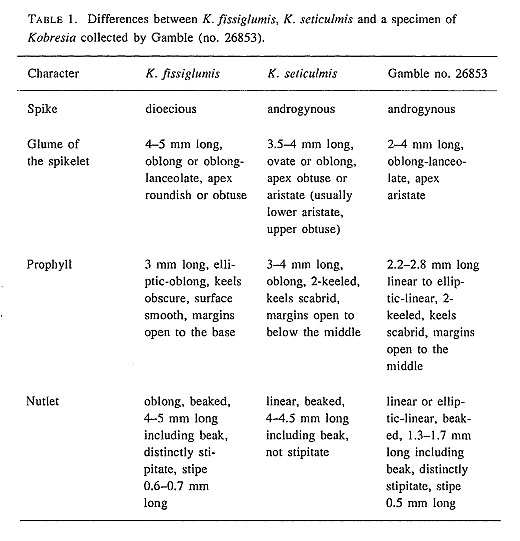
6) Kobresia fragilis C. B. Clarke in J. Linn. Soc. Bot. 36: 267 (1903)-Kükenthal in Engler, Pfl.-reich IV-20, 38: 50 (1909)-T. Koyama in Hara et al., Enum. Fl. Pl. Nepal 1: 113 (1978). [Plate 65b; Figs. 4a-g, 19]

Schoenoxiphium fragile (C. B. Clarke) C. B. Clarke in Kew Bull. Additional ser. 8: 67 (1908).
Rhizomes densely tufted. Culms 2-26 cm tall, 0.8-1 mm thick, erect, triquetrous or striated, smooth, base covered with pale brown lamina-bearing sheaths. Leaves
1-16 cm long; lamina linear, flat, up to 1.6 mm wide, glabrous, margin scabrous; sheaths membranous, glabrous, pale green; ligules minute, membranous, pale green.
Inflorescences erect, oblong, 1-2.5 cm long, 2-3 mm wide, consisting of many closely arranged spikes; axis triquetrous, smooth. Spikes oblong or ovate-oblong, 4-8 mm long, 2 mm wide, androgynous with about 3 female spikelets terminated by male. Glumes of the lowest spikes leafy, ovate, aristate, 3-6 mm long excluding arista, smooth, green, reddish brown, 3-5-nerved, arista up to 6.5 cm long and exceeding inflorescence; upper glumes as the same as the lowest but arista reduced. Glumes of the pistillate spikelets oblong or elliptic-oblong, shortly aristate or not, 2.2 mm long excluding arista, 1.5 mm wide, glabrous, brown, 1-nerved, nerve green, arista scabrid. Prophylls ellipsoid, 2.6-3.2 mm long, membranous, nerveless, smooth, pale green, small apical part hyaline, margins open from above down to just below the apex. Sterile rachillas of the female spikelets flat, 2.5 mm long, 0.6 mm wide, 2-nerved, green. Male glumes elliptic-oblong, obtuse, 2-2.7 mm long, 1-nerved, glabrous. Stamens 3. Styles 3-fid, 0.5-1.2 mm lone, base slightly thickened. Nutlets
obovoid or elliptic-ovoid, 2 mm long, 1 mm broad, slightly beaked, trigonous, smooth, reddish brown. Seeds elliptic-ovate, apex acute, 1.5 mm long, 1.3 mm broad, greenish yellow.
Distr.; Himalaya (Nepal), Tibet, SW China (Szechuan, Yunnan).
Specimens examined. NEPAL: Chakhure Lekh, S. of Jumla, 11500 ft. (Polunin, Sykes & Williams no. 4793, July 19, 1952, BM, TI); Tarakot, 3500 m (Einarsson, Skarby & Wetterhall nos. 1879, 1880. July 11, 1973, BM); Thanti, Manang District, 4100 m (Rajbhandari no. 8442, July 26, 1983, TI, KATH); Langtang valley, 13000 ft. (Schilling, Sayers & Bista no, 464, June 28, 1965, K).
Kobresia fragilis is not common in the Himalaya. It can be distinguished by the inflorescence with closely arranged spikes, leafy glumes of the lower spikes, the lowest longer than the inflorescence, and 2-nerved, flat, green, distinct sterile rachillas. Clarke (1903) and Kükenthal (1909) described some of the lateral spikelets of this species as bisexual but in the specimens examined all lateral spikelets were found to be female. This species resembles K. curvata.
7) Kobresia gandakiensis Rajb. et H. Ohba, sp. nov. [Plate 66a; Figs. 4h-o, 23]

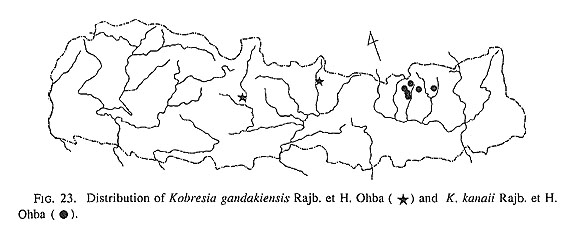
K. capillifolia non (Decne.) C. B. Clarke: T. Koyama in Hara et al., Enum. Fl. Pl. Nepal 1: 113 (1978).
Species inflorescentia Kobresiae capillifoliae (Decne.) C. B. Clarke optime congruens, sed prophyllo 1-1.2 (nec 3-3.5) mm longo, nuce breviore, margo versus basin profunde findente et lamina 0.8-1.5 (nec 0.3-0.5) mm lata complanata bene differt.
Perennial herbs. Rhizomes tufted. Culms slender, erect, 4-11 cm tall, striate, smooth, base covered with membranous, brown, laminaless outer sheaths. Leaves 4-8 cm long; lamina linear, flat, 0.8-1.5 mm wide, glabrous, margin scarcely scabrid; sheaths membranous, green.
Inflorescences erect, consisting of a single spike, axis smooth, sometimes bent. Spikes linear, 2-3.5 cm long, 3 mm wide, consisting of many spikelets, terminal spikelets male and others bisexual. Bisexual spikelets 3.5 mm long, with a female flower at base and 2-3 male flowers above it. Glumes of the bisexual spikelets oblong or oblong-elliptic, apex bilobed, mucronate or acute, 4-5 mm long, 2-2.2 mm wide, glabrous, palegreen, 1- nerved, lowest glumes not sheathing. Prophylls linear, acute, 1-1.2 mm long, 0.4 mm broad, membranous, smooth, brown, nerveless, keels obscure, margins open from above down to the base. Male glumes lanceolate, acute, 3-3.2 mm long, 1 mm wide, glabrous, brown, 1-nerved. Stamens 3; filaments slender, 4 mm long; anthers linear, 2.6 mm long, yellow. Styles slender, 3 mm long, 3-fid. Nutlets oblong, beaked, 2-3 mm long including beak, 0.5 mm broad, trigonous, yellowish brown, smooth. Seeds oblong, 1.5 mm long, 0.5 mm broad, greenish yellow, apex round.
Distr.: C Himalaya (Nepal).
Specimens examined. NEPAL: Kabre, Kali Gandaki Valley, 6500 ft. (Stainton, Sykes & Williams no. 5744, June 13, 1954, TI-holotype); Buri Gandaki Gorge, S of Jagat, 4000 ft. (Stainton no. 3939, July 5, 1962, BM, TI).
The shape of the inflorescence of Kobresia gandakiensis resembles that of K. ca
pillfolia (Decne.) C. B. Clarke which is distributed in central Asia, west Himalaya and China, but can easily be distinguished from it by the 1-1.2 mm long prophyll, which is shorter than the nutlet and the margins which are open to the base. Kobresia capillifolia has a 3-3.5 mm long prophyll, which is longer than the nutlet and the margins are open to below middle. They also differ in their leaves; the lamina of K. gandakiensis is flat and 0.8-1.5 mm wide, while it is filiform-involute and 0.3 -0.5 mm wide in K. capillifolia. We have examined the specimens of K. capillifolia collected from Afghanistan, Pakistan, Kashmir, Lahul, Garhwal and Tibet preserved at BM and K. K. capillifolia is found at high altitudes, especially above 3000 m, while K. gandakiensis has been collected near the large rivers at 1200-2000 m altitude in central Nepal.
8) Kobresia harae Rajb. et H. Ohba in J. Jap. Bot. 62: 193, f. l (1987). [Plate 66b; Figs. 5a-f, 18]
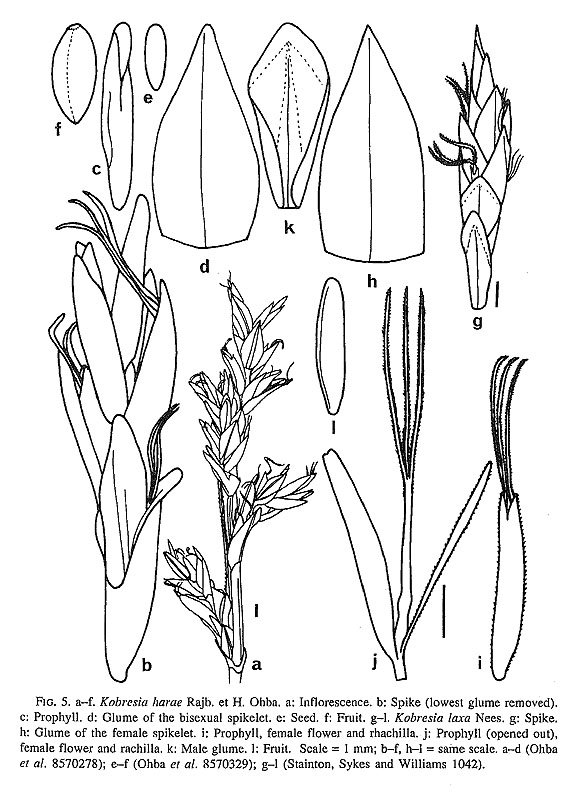

Rhizomes elongating, prostrate, 2.5-3.5 cm long, 1-1.5 mm thick, covered with lightbrown scales. Culms slender, erect, 10-26 cm tall, 0.5 mm thick, triquetrous, smooth; base covered with pale brown, lamina-bearing outer sheaths. Leaves shorter than culms, 2-14 cm long; lamina linear, flat, 1-2 mm wide, green, apex attenuate, margin scabrid, midrib scabrid or smooth; sheaths 1-3 cm long, pale green; ligules 0.5-1.5 mm long, membranous, pale brown.
Inflorescences erect, racemose or partly spiciform, oblong, 1.2-2.8 cm long, 0.5 -1 cm wide with many spikes; axis smooth. Spikes oblong, 7-9 mm long, 3-3.5 mm wide; with 5-8 spikelets, lowest and lateral bisexual and terminal one male, sometimes all bisexual or lateral few female. Glumes of the lowest spikes leafy or not, broadly ovate, 4 mm long, 2 mm wide, glabrous, greenish brown, margin hyaline, 1-nerved, apex long attenuate, up to 1.1 cm long, scabrid, base sheathing; upper ones broadly ovate, obtuse, pale green. Lowest spikelets with a female flower at base, a male flower and one or two sterile scales. Lateral spikelets elliptic or oblong- elliptic, 3.4-4.4 mm long, 1 mm broad, with one lower female and one or two upper male flowers, rarely the male flowers reduced. Glumes of the lateral spikelets ovate or ovate-elliptic, obtuse, 3-4.2 mm long, 0.6-2 mm wide, glabrous, pale brown, 1- nerved, margin hyaline. Prophylls linear or oblong-lanceolate, 3.2-4.2 mm long, 0.6 mm broad, membranous, smooth, palegreen, margin hyaline, nerveless or sometimes faintly 2-nerved, margins open down to below the apex to the middle. Sterile rachillas of the female spikelets minute, glabrous. Male glumes broadly elliptic-lanceolate, obtuse, glabrous, pale green, 1-nerved. Stamens 3, sometimes reduced to 2 or 1; filaments slender; anthers 1.2-2 mm long, yellow. Styles 3-fid, 1-1.5 mm long. Nutlets narrowly obovate, 1.7 mm long, 0.8 mm broad, trigonous, smooth, pale yellow. Seeds oblong-obovate, 1.2 mm long, 0.2 mm broad, greenish yellow.
Distr.: Himalaya (Nepal).
Specimens examined. NEPAL: Janakpur Zone, Ramechhap District, Serdingma - Dubikharka, 3400-3720 m (Ohba et al. no. 8570278, July 7, 1985, TI-holotype, KATH-isotype); Dubikharka - Baula Pokhari, 3720-3960 m (Ohba et al. no. 8570329, July 9, 1985, TI, KATH).
Kobresia harae resembles K. williamsii T. Koyama by having elongated rhizomes, bisexual spikelets, smooth prophylls and a 3-fid style, but can readily be distinguished from it by its smaller size, smaller prophylls and the glume of the lateral spikelet having an obtuse apex.
9) Kobresia kanaii Rajb. et H. Ohba, sp. nov. [Plate 67a; Figs. 6, 23]

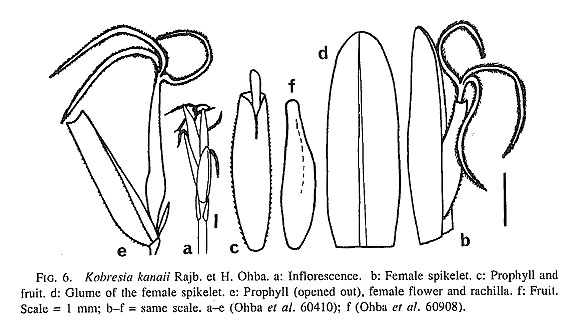
K. macrantha non Boeck.: T. Koyama in Hara et al., Enum. Fl. Pl. Nepal 1; 113 (1978).
Kobresia trinervi Boeck. primo adspectu maxime similis, sed a qua inflorescentiis femineis longitudine 1.5 cm vel multo brevioribus et glumis infimis ferminearum spicarum obtusis nec aristatis nec mucronatis multum recedit.
Rhizomes tufted or obliquely elongated, creeping, 1.5 mm thick, covered with light brown scales. Culms tufted, slender, erect or bent, 1.5-5 cm tall, sometimes up to 9 cm tall, 0.5 mm thick, triquetrous, scabrid, base covered with laminaless outer sheaths. Leaves up to 3 cm long, lamina linear, flat or convolute, 1 mm wide, smooth, margin scabrid; sheaths membranous, smooth; ligules small, membranous, smooth.
Inflorescences consisting of a single spike. Spikes unisexual. Female spike linear, densely arranged, 0.4-1 cm long, 1-3 mm wide, with 4-9 spikelets. Glumes of the female spikelet ovate-oblong or oblong, obtuse, 3.5-4 mm long, 1.3-1.5 mm wide, glabrous, reddish brown, 1-nerved. Prophylls oblong, 2.8-3.5 mm long, 0,6-0.7 mm broad, membranous, smooth, pale green, nerveless, apex truncate or obliquely bilobed, 2-keeled, keels scabrid, apical part reddish brown, margins open from above down to the middle. Sterile rachillas of the female spikelet up to 0.6 mm long. Styles 3- fid, 1.5 mm long, base slightly swollen. Nutlets oblong, beaked, 2.8 mm long including beak, smooth. Seeds linear-oblanceolate, obtuse, obscurely trigonous, 0.7 mm lone, 0.3 mm broad, reddish brown.
Distr.: Himalaya (C and E Nepal).
Specimens examined. NEPAL: Janakpur Zone, Ramechhap Distr., Around Jata Pokhari, 4400 m (Ohba, Kikuchi, Wakabayashi, Suzuki, Kurosaki, Rajbhandari & Wu no. 60410, July 17, 1985, TI-holotype in, KATH-isotype in); Around Jata Pokhari, 4220 m (Ohba et al. no. 8580325, July 18, 1985, TI, KATH); Panch Pokhari, 4220 m (Ohba et al. no. 8590150, July 15, 1985, TI); Bigphera Lho Glacier - Thare Og, 4700-4150 m (Ohba et al. no. 8590358, July 28, 1985, TI); Jata Pokhari - Botase Kharka, 4300 m (Ohba et al. no. 60446, July 20, 1985, TI, KATH); Thare Og - Neju, 4800 m (Ohba et al. no. 60908, July 30, 1985, TI, KATH); Sagarmatha Zone, Solukhumbu Distr., Below Dudhkund - Beni Kharka, 4750 m (Rajbhandari no. 61838, Aug. 30, 1985, TI, KATH); Khumbu, N of Langboche Khola, 15800 ft. (Bowes Lyon no. 2188, July 1, 1964, BM).
Kohresia kanaii resembles K. trinervis Boeck. But its habit and inflorescence clearly distinguish it from K. trinervis. In K. trinervis the female inflorescence is more than 2 cm long, whereas in this species it is less than 1.5 cm long. In K. trinervis the lowest glume of the female spike is often aristate or mucronate, but in this species it is simply obtuse and never aristate.
Kobresia kanaii grows gregariously in moist places, on mossy ground as well as on open slopes and open ridges of the alpine region. Most of the specimens collected were either around big glacial lakes in the alpine region or near glaciers. We named this species in honour of Dr. Hiroo Kanai of the National Science Museum, Tokyo, for his interest in the Himalayan plants.
10) Kobresia laxa Nees in Wight, Contrib. Bot. Ind. 119 (1834)-Kükenthal in Engler, Pfl.-reich IV-20, 38: 47, t. 11 (1909)-C. B. Clarke in Hook. f., Fl. Brit. Ind. 6: 698 (1894); in Kew Bull. Additional ser. 8: 137 (1908)-T. Koyama in Ohashi, Fl. E. Himal. 3: 128 (1975); in Hara et al., Enum. Fl. Pl. Nepal 1: 113 (1978). [Plate 67b; Figs. 5g-l, 24]
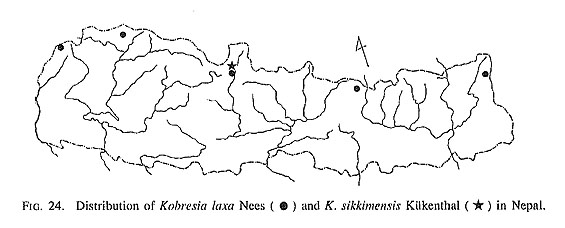
K. pseudolaxa C. B. Clarke in J. Linn. Soc. Bot. 20: 381 (1883).
Hemicarex laxa (Nees) Benth. in J. Linn. Soc. Bot. 18: 367 (1881)-C. B. Clarke, loc. cit. 20: 385, t. 30 f. 5-6 (1883).
Rhizomes loosely tufted, 2-3 mm thick, covered with brown scales. Culms 3-38 cm tall, lower part triquetrous, smooth, upper biconvex; base covered with brown, lamina-bearing sheaths; outermost sheath scale-like. Leaves 4-32 cm long; lamina linear, flat, 2 mm wide. surface glabrous, margin scabrous, apex subulate becoming triquetrous; sheaths membranous, smooth, brown.
Inflorescences spiciform, linear or oblong-elliptic, up to 8 cm long, 1 cm wide, consisting of loosely arranged spikes; axis triquetrous, scabrid, curved. Glumes of the lowest spikes leafy often overtopping the inflorescence. Spikes linear-lanceolate, 1-2 cm long, 2 mm broad, curved or not, consisting of a few lateral unisexual or bisexual spikelets and terminal male, lowest spikelet female. Glumes of the female spikelets ovate or oblong, aristate in lowest, round or obtuse or rarely aristate in upper, 3.5-5 mm long excluding arista, 1-2 mm wide, glabrous, reddish brown, apical marginal part broadly hyaline; 1-nerved, nerve green. Prophylls linear, sometimes slightly curved, 3.5-4.5 mm long, 0.5-0.7 mm broad, membranous, smooth, light green, 2-nerved and 2-keeled, keels slightly scabrid, apical portion reddish brown, margins open from above down to just below the apex. Sterile rachillas of the female spikelet up to 4-4.5 mm long, exserted from the prophyll or as long as it, flat, green, margin scabrid. Male glumes ovate, acute, glabrous, reddish brown, 1-nerved. Stamens 3; filaments slender, 5-6 mm long; anthers 2-3 mm long. Styles 3-fid, 0.5-1 mm long, base slightly swollen. Nutlets narrowly oblong or elliptic-oblong, 2.5-3 mm long, 0.6 mm broad, smooth, pale-yellow or brown. Seeds oblong, obtuse, 1 mm long, 0.5 mm broad, greenish yellow.
Distr.: Himalaya (Karakorum, Punjab to Sikkim), Tibet.
Specimens examined. W HIMALAYA: Swat, Sho Nala (Stewart & Rahman no. 25198, K); Karakoram, Gilgit, 1500 m (Nakao s.n., TNS); Chitral, Sholeor Shal, E of Main Barun Glacier, ca 3600 m (Wendelbo s.n., K); Hazara, Kagan valley (Ali no. 177, K); Kagan valley (Inayat no. 20263, K); Hazara, 9000 ft. (Duthie no. 20264, K); Hazara (Inayat no. 20264, K); Darakelu, Siram Range, 10400 ft. (Inayat no. 23278, K); Siram valley (Inayat no. 20261, K); Punjab (Drummond nos. 24143, 24144, 24145, K); Lahul, 10500 ft. (Bor no. 12298, K); Lahul, 10200 ft. (Bor nos. 14631, and 11927, K); Kashmir, Said Valley, 7000-8000 ft. (Duthie no. 11479, June 25, 1892. BM); Alibad, 10000 ft. (Clarke, no. 28693, BM-isotype of K. pseudolaxa C. B. Clarke); Mapanon, 9000 ft. (Clarke no. 29566, BM, K); Barumgalli, 6500 ft. (Clarke no. 28412, K); Gurais, 8000 ft. (Clarke no. 29491, K); Gurais Valley (Winterbottom no, 549, K); Sonamarg, 10500 ft. (Stewart no. 9742, K); Kishenganga valley, 7500 ft. (Stewart no. 17913, K); Pir Panjal, 9000 ft. (Drummond no. 13912, K); W Himalaya, 6000-8000 ft. (Thomson s.n., K, BM); W Himalaya (Jacquemont no. 1261, K); Baltistan, Satpur Mullum, 10000-11000 ft. (Duthie no. 12027, K); Tehri Garhwal, Joda Gadh, 7500 ft. (Gamble s.n., K); Tehri Garhwal, 7000 ft. (Gamble no. 24222, K); Ganges Valley, 9000-10000 ft. (Duthie no. 74, K); Damodar Valley, 11000 ft. (Duthie no. 75, K); Kumaun, Dhauli Valley, 8000-9000 ft. (Duthie no. 6114, K). Nepal: Opposite Budhi Village, 10000-11000 ft. (Duthie no. 6090, July 18, 1886, BM); Dozam Khola, near Timikot, 11000 ft. (Polunin, Sykes & Williams no. 4225, May 30, 1952, TI); Lete, S. of Tukucha, Kali Gandaki, 11000 ft. (Stainton, Sykes & Williams no. 1042, June 9, 1954, BM,TI); Kyanging - Langtang Gorge, 3800-3000 m (Kanai & Shakya no. 129, July 16, 1970, TI); Kangrang La, 12000 ft. (Williams no. 731, June 17, 1969, TI). SIKKIM: Sikkim, Lachen, 11000-12000 ft. (Hooker f. s.n., July 12, 1849, BM, K).
Kohresia laxa can be distinguished from other species of the genus by its bright red, loose, paniculate inflorescence with leafy glumes of the lowest spikes, slightly curved spikes, bright red-brown, oblong glumes and a distinctly developed sterile rachilla in the female spikelets. In habit it resembles K. sikkimensis Kükenthal but the prophyll is linear in this species while it is elliptic in K. sikkimensis.
11) Kobresia macrantha Boeck., Cyper. Nov. 1: 39 (1888)-C. B. Clarke in Hook. f., Fl. Brit. Ind. 6: 699 (1894), excl. syn- Kükenthal in Engler, Pfl.-reich IV-20, 38: 50 (1909). [Plate 68a; Figs. 7, 27]
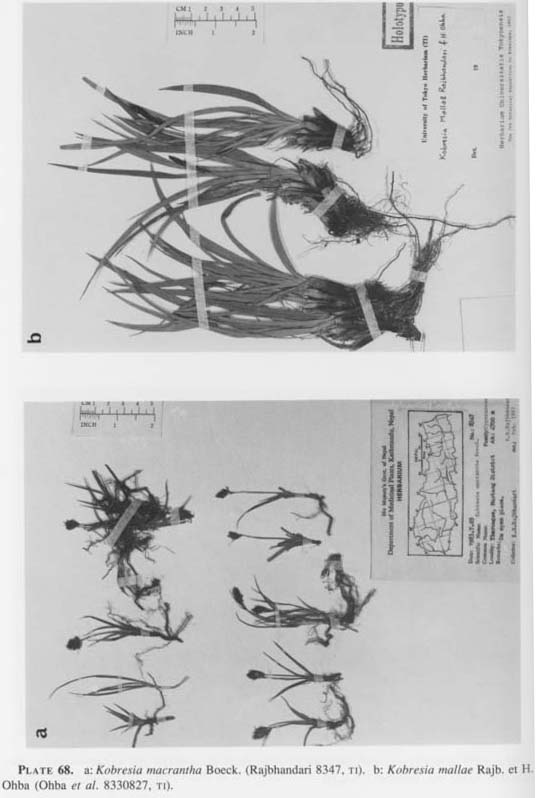

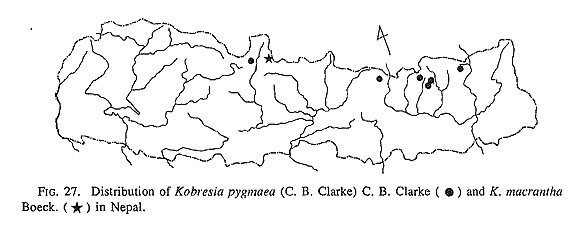
Rhizomes slender, elongated, 1.2 mm thick. Culms erect, up to 6 cm tall, triquetrous, smooth; base covered with light brown, lamina-bearing outer sheaths. Leaves 2-5 cm long; lamina linear, flat, 1.5-2 mm wide, surface glabrous, margin scabrellate or smooth; sheaths herbaceous, light brown; ligules minute, membranous, light brown.
Inflorescences erect, elliptic, up to 1.5 cm long, 0.6 cm wide, consisting of several closely arranged spikes; axis smooth. Spikes elliptic, 6 mm long, consisting of lateral
bisexual or female spikelets and terminal male spikelet. Lowest spikelets female. Bisexual spikelets with lower female and upper one or two male flowers. Glumes of the lowest spikes ovate, aristate, 5-6 mm long (excluding arista), 3 mm wide, glabrous, green in middle and chestnut-brown in lateral sides, 1-3 nerved, arista scabrid. Glumes of pistillate spikelets ovate, sub-acute, or obtuse, 4.5 mm long, 2 mm wide, 1-nerved, glabrous, reddish brown, basal and apical parts hyaline. Prophylls linear, 3.6 mm long, membranous, smooth, reddish brown, nerveless, 2-keeled, keels smooth, margins open from above down to the base, but in the prophylls of the upper spikelets margins fused at basal part. Male glumes ovate, obtuse, 4.2 mm long, glabrous, reddish brown, 1-nerved, lower hyaline. Stamens 3; filaments slender, 5-6 mm long; anthers 3 mm long. Style 2-fid, 0.5-0.7 mm long. Nutlets ovoid, flattened, 1.6 mm long, 0.8 mm broad, stipitate, smooth. Seeds oblong, obtuse, 0.5 mm long, greenish brown.
Distr.: Himalaya (Nepal), Western Tibet.
Specimens examined. NEPAL: Thorungse, Mustang District, 4700 m (Rajbhandari no. 8347, July 25, 1983, TI, KATH). TIBET: Nubra Valley (Schlagintweit s.n., July 24-31, 1856, BM-isosyntype?); SE Tibet, Konebo Province, between Charko and Lilune Chu. 10200 ft.(Ludlow, Shernff & laylor no. 4456, BM).
Kobresia macrantha is a rare species in the Himalaya. At Thorungse in central Nepal it was growing at an altitude of 4700 m in open rocky places with species of Poa, Saussurea, Corydalis, Androsace, Arenaria.
The structure of the prophyll of K. macrantha resembles that of K. schoenoides (C. A. Meyer) Steudel, but differs from it in having more than one spike in the inflorescence and also in the stipitate nutlet and the distigmatic pistil. It also resembles K. royleana (Nees) Boeck. in inflorescence structure, but can also be readily distinguished from it by its distigmatic pistil and stipitate nutlet.
12) Kobresia mallae Rajb. et H. Ohba in J. Jap. Bot. 62: 257, f. 2A-H, 3A (1987). [Plate 68b; Figs. 8a-h, 21]

Rhizomes tufted, 2.5 mm thick, thickly covered with chestnut-brown sheaths. Culms slender, erect, 4-10 cm tall, 0.8 mm thick, triquetrous, scabrid; basal outer sheaths oblong, 2.5-3 cm long, 6-8 mm wide, testaceus, laminaless, apex round, surface shining, smooth. Leaves, basal longer than culms, lamina linear, flat, setaceous, 4-5 mm wide, surface glabrous, margin scabrid, those on culm narrower; sheaths membranous, smooth, pale yellow; ligules minute, membranous, pale yellow.
Inflorescences unisexual, consisting of a single spike. Male spikes oblong, 1.5- 5 cm long, 3 mm wide, axis triquetrous, smooth. Female spikes linear, 2-3 cm long, 3 mm wide, with densely arranged spikelets, lower spikelets sometimes lax; axis triquetrous, smooth. Glumes of the lower female spikelet ovate-oblong or oblong, apex aristate, 3.2-4.5 mm long excluding arista (arista up to 8 mm long), 1-1.2 mm wide, membranous, glabrous, reddishbrown, 1-nerved, nerve green; upper glumes with obtuse or round apex. Prophylls ovate or elliptic-oblong, 2 mm long, 0.6-0.7 mm wide, glabrous, upper half brown, lower pale green, margins open from above nearly to the base; nerveless, keels obscurely visible, smooth or rarely slightly scabrellate at the lower part. Sterile rachillas of the female spikelet up to 0.5 mm long. Male glumes oblong, obtuse, 6 mm long, 1.6 mm wide, glabrous, reddish brown above, greenish below, 1-nerved. Stamens 3; filaments slender, 6 mm long; anthers 2.8- 3 mm long, yellowish brown. Styles 3-fid, 1.5-2 mm long, linear. Nutlets elliptic- oblong, slightly beaked, 1.5-2 mm long including beak, 0.6 mm broad, slightly trigonous, smooth, pale yellow. Seeds oblong-obovate, obtuse, trigonous, 1.6 mm long, 0.7 mm broad, greenish yellow.
Distr.: Himalaya (C Nepal).
Specimens examined. NEPAL: Dhaulagiri Zone, Mustang Dist., Throng Phedi, 4000 m (Ohba et al. no. 8330827, July 24, 1983, TI-holotype, KATH-isotype); Muktinath - Throng Phedi, 3550 -4000 m (Ohba et al. no. 8310673, July 23, 1983, TI, KATH); Nr. Pudamigaon, Nr. Suili Gad, 12000 ft. (Polunin, Sykes & Williams no. 2235, June 17, 1952, BM, TI); Muktinath, 1500 ft. (Stainton, Sykes & Williams no. 1456, June 26, 1954, TI).
Kobresia mallae resembles K. trinervis Boeck. in having flat leaves and unisexual spikes but differs by having a 2 mm long smooth prophyll, the margins of which are open nearly to the base, and the elliptic-oblong, 2 mm long nutlet. In K. trinervis the prophyl is 3-4 mm lone, with a scabrid keel and the margins are open to the
middle. The nutlet is elliptic and 3-4.5 mm long. It is noticeable that in K. mallae the outer basal sheaths are characteristic in being testaceous, shining and laminaless. K. mallae also resembles K.fissiglumis, described by C. B. Clarke from West Nepal, but the pistil in the latter is distinctly stipitate. The length of the nutlet of K. fissiglumis is 4 mm, but in K. mallae it is only 2 mm.
13) Kobresia nepalensis (Nees) Kükenthal in Engler, Pfl.-reich IV-20, 38: 40, f. 9 (1909)-T. Koyama in Ohashi, Fl. E. Himal. 3: 128 (1975); in Hara et al., Enum. Fl. Pl. Nepal 1: 113 (1978). [Plate 69a; Figs. 9a-g, 25]
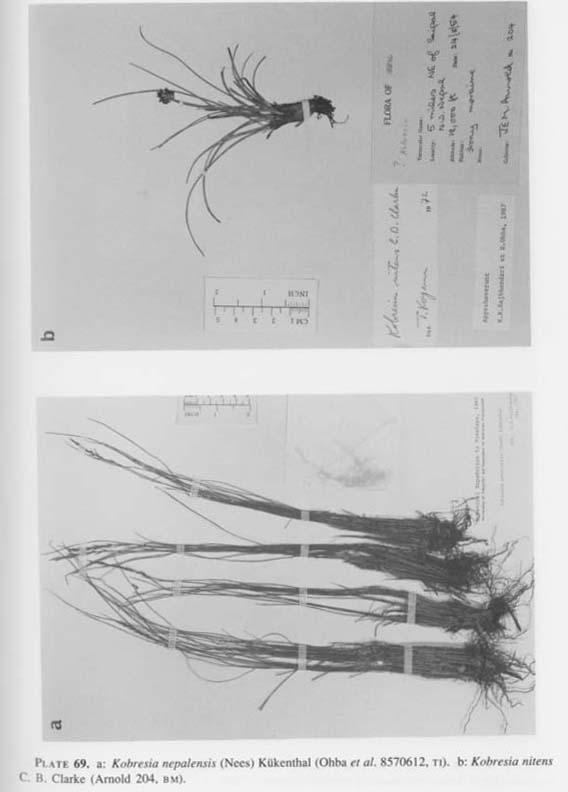
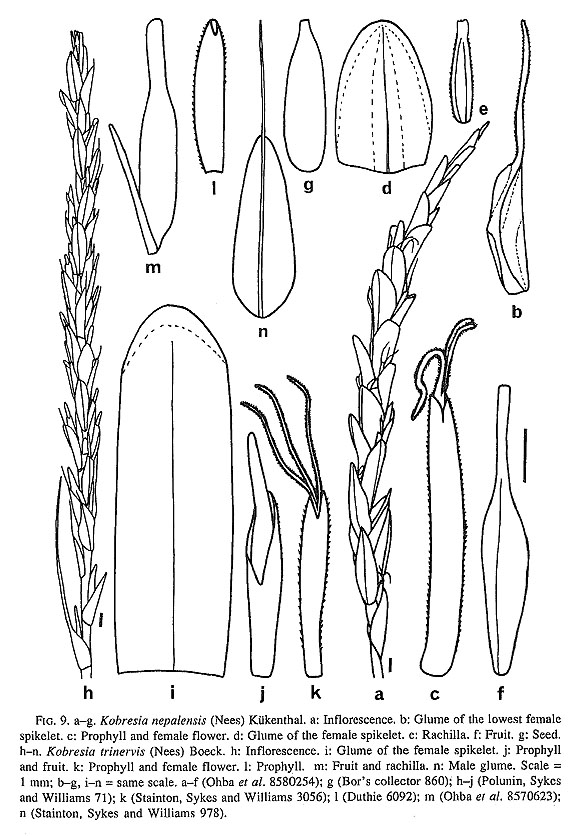

Uncinia nepalensis Nees in Wight, Contrib. Bot. Ind. 129 (1834).
Carex linearis Boott, Illustr. Carex 1: 51, t. 136 (1858)-C. B. Clarke in Hoo
k. f., Fl. Brit. Ind. 6: 712 (1894).
Hemicarex linearis (Boott) Benth. in Journ. Linn. Soc. Bot. 18: 367 (1881).
Kobresia vaginosa C. B. Clarke in Hook. f., Fl. Brit. Ind. 6: 695 (1894); in Kew Bull. Additional ser. 8: 136 (1908).
Kobresia nepalensis var. vaginosa (C. B. Clarke) Kükenthal in Engler, Pfl.-reich IV-20, 38: 40 (1909).
Kobresia nepalensis subsp. vaginosa (C. B. Clarke) T. Koyama in Hara et al., Enum. Fl. Pl. Nepal 1: 113 (1978).
Rhizomes tufted. Culms erect, 2-44 cm tall, triquetrous or striate, smooth; base covered with chestnut brown laminaless outer sheaths. Leaves as long as culms or longer; lamina filiform, convolute, 0.3-1.1 mm wide, surface glabrous, margin scabrid; sheaths membranous, smooth, pale green; ligules minute, pale green.
Inflorescences erect, linear, 1.5-7 cm long, 1-4 mm wide, consisting of a single spike; axis smooth. Spikes androgynous with female spikelets below and terminated by male spikelet, sometimes spikes unisexual, spikelets densely arranged or lower partly loose. Glumes of the female spikelets ovate, obtuse, or aristate, 3-7 mm long, 2-3.5 mm wide, glabrous, reddish brown, 1-nerved, margin and apical part hyaline; lowest glumes long aristate, arista up to 3.2 cm long, base not sheathing. Prophylls linear-oblong, 4-7 mm long, 1.5-1.7 mm broad, membranous, smooth, green, reddish brown in margin and apical part, nerveless, 2-keeled, keels scabrid, margins open from above down to below the apex or up to the base. Sterile rachillas of the female spikelets flat, up to 1.7 mm long, 0.2 mm wide, surface glabrous, green, margin scabrid, 2-nerved. Male glumes oblong, obtuse, 7.5 mm long, 1.5 mm wide, glabrous, yellowish brown, 1-nerved. Stamens 3; filaments slender, 6-9 mm long; anthers 3 mm long. Styles 3-fid, 1-2 mm long, linear. Nutlets oblong or oblanceolate, beaked, 4.5-6.5 mm long including beak, 0.8-1 mm broad, included in prophyll, or slightly exserted, smooth, pale yellow to reddish brown, base attenuate into a short stalk. Seeds oblong-oblanceolate or oblong-lanceolate, obtuse or truncate, 2.6-2.8 mm long, 0.6-0.7 mm broad, greenish yellow, slightly stipitate.
Distr.: Himalaya, Tibet, S W China (Yunnan).
Specimens examined. W HIMALAYA: Swat (Stewart & Rahman no. k 25026, K); Punjab, Kunawar (Drummond no. 22436, K); Hazara, 14000 ft. (Duthie no. 23279, K); Kashmir, Pir Pinjal, 11000 ft. (Clarke no. 28754, BM); Musjid valley, 12000-13000 ft. (Duthie no. 13197, K); Liddar valley, 12000 ft. (Duthie no. 13133, K); Above Gulmarg, 13000 ft. (Stewart no. 8892 A, K); Mozufferabad (Duthie no. 22639 a, K); Tragbol, 11400 ft. (Clarke no. 29266, K); Kedarkanta (Jacquemont no. 480, K); Garhwal, Jumnotri, 12000-13000 ft. (Duthie no. 300, BM); Nila valley, 13000-14000 ft. (Duthie no. 376, K). NEPAL: Nampa Gadh, 13000-14000 ft. (Duthie no. 6091, July 27, 1886, BM); Maharigaon (Khola), 14000 ft. (Polunin, Sykes & Williams no. 1566, BM); Maharigaon, 3 miles NE, 14500 ft. (Polunin, Sykes & Williams no. 132, July 13, 1952, TI); Bhurchula Lekh, near Jumla, 12500 ft. (Polunin, Sykes & Williams no. 4680, July 14, 1952, TI); Jangla Banjang, 3800 m (Einarsson, Skarby & Wetterhall no. 3583-3584, Aug. 18, 1973, BM); Above Sauwala Khola, 12500 ft. (Stainton, Sykes & Williams no. 2994, June 5, 1954, K); Near Sauwala Khola, 11500 ft. (Stainton, Sykes & Williams no. 2959, June 3, 1954, BM, TI); Sialgarhi, Chaudhabise Khola, 9500 ft. (Polunin, Sykes & Williams no. 2072, May 20, 1952, TI); Nr. Dojam Khola, Nr. Suli Gad, 12500 ft. (Polunin, Sykes & Williams no. 2291, June 22, 1952, BM, TI); Dhaulagiri Himal, below Marpha Peak, between Yak Pass and Dhampus Pass, 14000-14500 ft. (Jones no. V-59, BM); Thorungse Phedi, Mustang Dist., 4050 m (Rajbhandari no. 8298, July 24, 1983, TI, KATH); Cha Lungpa, 13500 ft. (Miehe no. 425, BM); Sangda-La, 17400 ft. (Miehe no. 446, BM); Lete, S of Tukucha, 11000 ft. (Stainton, Sykes & Williams no. 1030, June 7, 1954, TI); Thinigaon, Muktinath Himal, 15000 ft. (Stainton, Sykes & Williams no. 1351, June 23, 1954, TI); Samargaon, N of Tukucha, 15000 ft. (Stainton, Sykes & Williams no. 7278, Aug. 16, 1954, BM, TI); Tilicho Phedi, Manang Dist., 4050 m (Rajbhandari no. 8694, Aug. 1, 1983, TI, KATH); Annapurna Himal, Seti Khola, 12500 ft. (Stainton, Sykes & Williams no. 6579, Aug. 2, 1954, BM); Saptse Lungpa, nr. Annapurna II Base Camp, 15000 ft. (Miehe no. 705, BM); Rambrong. Lamjung Himal, 13000 ft. (Stainton, Sykes & Williams no. 6193, July 6, 1954, TI); Mul Kharka, Chilime Khola, 3800-4100 m (Kanai & Shakya no. 672315, TI); Chilime Kharka, 15000 ft. (Polunin no. 1176, July 1949, BM, TI); Kyangchin Comba, 4200 m (Dobremez no. 1094, BM); Gosainkund, 4280 m (Haas no. 2247, BM); Ganja La Himal, 4400 m (Dobremez no. 497, BM); Sringi Himal, Shiar Khola, 14000 ft. (Gardner no. 625, May 28, 1953, TI); Ganesh Himal, Shiar Khola, 13000 ft. (Gardner no. 1382, BM); Lari, 4550 m (Yon no. 302, BM); Beding Nagaon, Dolakha District, 3800 m (Rajbhandari no. 9878, Sept, 4, 1983, TI, KATH); Janakpur Zone, Ramechhap Distr., Dubikharka- Baula Pokhari, 3720-3960 m (Ohba et al. no. 8580211, July 9, 1985, TI); Baula Pokhari - Chhu Ningma, 3960-4040 m (Ohba et al. nos. 8580254, 8570388, July 11, 1985, TI); Around Jata Pokhari, 4220 m (Ohba et al. no. 8590116, July 13, 1985, TI); Jata Pokhari - west of Panch Pokhari, 4220-4560 m (Kurosaki, Rajbhandari & Wu nos. 8580297, 8570451, July 14, 1985, TI, KATH); Jata Pokhari - Panch Pokhari, 4220-4500 m (Ohba, Wakabayashi & Wu no. 8530338, July 17, 1985, TI); Jata Pokhari Panch Pokhari Deorali, 4350 m (Ohba & Rajbhandari no. 60383, July 16, 1985, TI, KATH); Jata Pokhari - western slope of a peak, 4700-4800 m (Suzuki & Kurosaki nos. 8570503, 8570510, July 17, 1985, TI); Jata Pokhari - Botase Kharka, 4200 m (Ohba et al. nos. 60447, 60453, 60454, July 20, 1985, TI, KATH); Botase Kharka - Koshing Kharka, 4250 m (Ohba et al. nos. 60517, 8570612, July 21, 1985, TI, KATH); Koshing Kharka - Thare Og, 3650 m (Ohba et al. no. 8580383, July 22, 1985, TI); Around Thare Og, 4000 m (Ohba et al. no. 60626, July 23, 1985. TI, KATH); Thare Og - Bigphera Lho Glacier, 4700 m (Ohba, Kikuchi & Rajbhandari no. 60692, July 25, 1985, TI, KATH); Bigphera Lho Glacier - Thare Og, 4700-4150 m (Ohba et al. nos. 8590355, 8590356, 8590357, July 28, 1985, TI); Sagarmatha Zone, Solukhumbu Distr., Thosa Kharka - Beni Kharka, 3700 m (Ohba et al. no. 61642, Aug. 22, 1985, TI, KATH); Around Dudh Kund, 4500 m (Ohba et al. no. 8581200, Aug. 27, 1985, TI); Below Dudh Kund - upper Dudh Kund Glacier, 4460 m (Rajbhandari nos. 61787, 61771, 61793, Aug. 29, 3985, TI, KATH); Below Dudh Kund - Beni Kharka, 4750 m (Rajbhandari
no. 61855, Aug. 30, 1985, TI, KATH); Kumbakarna Himal, Lower Barun Valley, 4850 m (Wraber no. 270, BM); Arun - Tamur Watershed, S of Topke Gola, 13500 ft. (Stainton no. 893, July 9, 1956, BM, TI). SIKKIM: Sikkim, 13000 ft. (Hooker f. s.n., BM); Jelep La, 14000 ft. (Bor's collector no. 859, K); Nathula, 14000 ft. (Bor's collector no. 260, K). ASSAM: Okra La. 13000 ft. (Kingdon-Ward no. 13737, BM). TIBET: Yatung, 12500 ft. (Bor & Kiratram no. 20188, K).
In one of the specimens examined (Rajbhandari 9878) collected at Beding, central Nepal at 3800 m altitude, the inflorescence axis is bifurcated, which is unusual in this species. The glumes of the lowest female spikelets are aristate, but an acute apex is also sometimes found. The prophyll is longer or sometimes as long as the glume and rarely shorter. Koyama (1978), while distinguishing two subspecies in this species, noted that in the typical one the spike is usually androgynous and has a 5 -6 mm long prophyll, while subsp, vaginosa is more frequently dioecious and has larger prophylls (7-8 mm long), but, since the variation was found to be continuous, and the shorter prophylls are found in dioecious specimens and larger prophylls in androgynous specimens, the two subspecies cannot be recognized as distinct.
14) Kobresia nitens C. B. Clarke in J. Linn. Soc. Bot. 20: 379, t. 30, f. 7 (1883); in Kew Bull. Additional ser. 8: 137 (1908); in Hook. f., Fl. Brit. Ind. 6: 697 (1894)-Kükenthal in Engler, Pfl.-reich IV-20, 38: 34, f. 7A-D (1909)-T. Koyama in Hara et al., Enum. Fl. Pl. Nepal 1: 113 (1978). [Plate 69b; Figs. 10, 26]


Rhizomes densely tufted. Culms erect, 3-45 cm tall, 1-1.5 mm thick, striate, smooth; base covered with brown, laminaless sheaths. Leaves longer or shorter than culms, up to 26 cm long, lamina linear, incurved, 0.5 mm wide, surface glabrous, margin scabrid; sheaths membranous, pale yellow with hyaline margin; ligules minute, membranous, brown.
Inflorescences erect, consisting of a single spike. Spikes ovate or oblong, 0.8-1.8 cm long, 0.3-1 cm wide, consisting of 6-15 densely arranged spikelets, terminal male, others bisexual. Bisexual spikelets ovate, 5-6 mm long, 2.5 mm broad, with a female flower at base and terminal 1-3 male flowers, sometimes in a few upper lateral spikelets male flowers reduced. Glumes of the bisexual spikelets ovate, obtuse, 4.5-5 mm long, 3-4 mm wide, glabrous, reddish-brown, 1-3-nerved, nerve green, lowest glumes sometimes aristate. Prophylls ovate-elliptic or elliptic, 5-6.5 mm long, 2.2-3.5 mm broad, membranous, smooth, yellowish brown, margins open from above down to below the apex; nerves obscure or sometimes many-nerved and distinct, 2-keeled, keels smooth or slightly scabrid on the upper part. Sterile rachillas of the female spikelets flat, green, 1-nerved, with or without sterile glume. Male glumes oblong, obtuse, 3-3.7 mm long, 1.8-2 mm wide, glabrous, brown, 1-nerved. Stamens 3; filaments slender, 5-6 mm long; anthers 1.2-2.4 mm long. Styles 3-fid. Nutlets obovate or broadly elliptic, shortly beaked, 3.5 - 4.5 mm long including beak, 1.7-2 mm broad, trigonous, smooth, yellowish brown, beak scabrous. Seeds obovate, 2 mm long, 1.2 mm broad, greenish yellow, apex round.
Distr.: Karakoram, W and C Himalaya.
Specimens examined. W HIMALAYA: Karakoram, Sokha Glacier, 13000 ft. (Russell no. 1863, BM); Gharesa Glacier Base Camp, 13 miles east of Nagar, 15800 ft. (Polunin no. 6213,BM); Kashmir, Burzil Pass, 14000 ft. (Stewart no. 22072, K); Above Gulmarg, 13000 ft. (Stewart no. 8863, K); Alibad, 11000 ft. (Clarke no. 28918, K); Sensal Nullah, Reddai Valley, 13000-14000 ft. (Duthie no. 13383, K); Baltistan, Chatpani Nala, 13000 ft. (Duthie no. 13882, Aug. 29, 1893, K); Kolohoi Valley, Pass, 14200 ft. (Polunin no. 56/548, Aug. 27, 1956, BM); Lahul, Bara-lacha (Bor's collector no. 171, K); Kailing-ka-Joh (Bor's collector no. 69, K); Hazara, Nilu, Kagan (Inayat no. 22638, K); Hazara (Duthie no. 23277, K); Kagan Valley, 14400 ft. (Inayat no. 20259, K); Gilgit, Nittar Valley, 10000-11000 ft. (Duthie s.n., K); Dudu Glacier, Tihri-Garhwal, 14000-15000 ft. (Duthie no. 370, BM); Kumaun, Dhauli Valley near Bidang, 14000-15000 ft. (Duthie no. 3462, K). NEPAL: 5 miles NE of Saipal, NW Nepal, 18000 ft. (Arnold no. 204, Aug. 24, 1954, BM).
Kobresia nitens, a rare species in Nepal, based on only one collection, resembles K. schoenoides (C. A. Meyer) Steudel but can be distinguished by its ovate spikelet and glumes of the bisexual spikelets and the elliptic prophylls. In K. schoenoides
the spikelets, glumes and prophylls are oblong. The margins of the prophyll in K. schoenoides are open to the base; in K. nitens the margins are open only to below the apex.
15) Kobresia pygmaea (C. B. Clarke) C. B. Clarke in Hook. f., Fl. Brit. Ind. 6: 696 (1894); in Kew Bull. Additional ser. 8: 137 (1908)-Kükenthal in Engler, Pfl.-reich IV-20, 38: 39 (1909)-Ohwi in Hara, Fl. E. Himal. 2: 151 (1971)-T. Koyama in Ohashi, Fl. E. Himal. 3: 128 (1975); in Hara et al., Enum. Fl. Pl. Nepal 1: 113 (1978), pro parte. [Plate 70a; Figs. 11a-g, 27]


Hemicarex pygmaea C. B, Clarke in Joum. Linn. Soc. Bot. 20: 383 (1883).
Rhizomes densely tufted, 1-2 mm thick, covered with brown scales. Culms 0.4-6 cm tall, up to 0.5 mm thick, triquetrous or striate, green, smooth; base covered with brown, lamina-bearing outer sheaths. Leaves up to 6 cm long; lamina setaceous, convolute, 0.3 mm wide, smooth, rarely flat and up to 0.7 mm wide with scabrid margin; sheaths up to 1 cm long, membranous, glabrous, brown; ligules minute, membranous, brown.
Inflorescences erect, consisting of a single unbranched spike; axis smooth. Spikes unisexual or androgynous, with densely arranged spikelets; female and androgynous ones linear, 3-7 mm long, 1.5 mm wide; male ones up to 1.5 cm long, 3 mm wide; spikelets 4-6 in female spike, often terminated by two sterile glumes; androgynous spikes with 4-7 female spikelets terminated by male with about three glumes; male spikes with 8-12 fertile glumes. Glumes of the female spikelets ovate, obtuse or aristate, glabrous, yellowish or reddish brown, 1-nerved, nerve green; lowest glumes in the spikes sheathing or not. Prophylls broadly elliptic, membranous, nerveless, smooth, apical part reddish brown, margins open from above down to the middle or up to below the middle. Sterile rachillas of the female spikelets up to 1.2 mm long, green, margin scabrellate, 2-nerved. Male glumes in androgynous spike ovate-lanceolate, 4 mm long, 1.2 mm wide; in male spike ovate, obtuse or lower mucronate, 5 mm long, 3 mm wide, glabrous, reddish brown, 1-nerved, nerve green. Stamens 3; filaments slender, up to 5 mm long, brown; anthers 1.8-2.6 mm long. Styles 3-fid, 0.6-1 mm long, linear. Nutlets oblong or obovate, slightly beaked, 1-2 mm long, 0.5-1 mm broad, trigonous, smooth, yellowish green to dark reddish brown. Seeds ovate-oblong, obtuse, 1.4 mm long, 0.8 mm broad, greenish yellow.
Distr.: Himalaya, Tibet, SW China (Yunnan).
Specimens examined. NEPAL: Sangda La, 17200 ft. (Miehe no. 467, Aug. 11, 1977, BM); Cha Lungpa, 17500 ft. (Miehe no. 547, Aug. 27, 1977, BM); Langtang Valley, ca 13000 ft. (Schilling, Sayers & Bista no. 463, June 18, 1965, K); Kyangjin Ghyang, 13500 ft. (Polunin no. 1663, Aug. 1949, BM); Langtang - Kyanging, 3800 m (Kanai & Shakya no. 672505, July 13, 1970, TI, KATH); Dudh Kunda, Dolakha District, 4550 m (Rajbhandari no. 9964, Sept. 5, 1983, TI, KATH); Sagarmatha Zone, Solukhumbu District, below Dudh Kund - upper Dudh Kund Glacier, 4700 m (Rajbhandari no. 61775, Aug. 29, 1985, TI, KATH); Benikharka - Tschokarma, 4600 m (Rajbhandari no. 61857, Aug. 31,1985, TI, KATH); Makalu, Barun Valley, 5100 m (Wraber no. 237, Sept. 19, 1972, BM). SIKKIM: Sikkim, 14000-17000 ft. (Hooker f. s.n., BM). BHUTAN: Yabu Thang - Laya, 3200 m (Kanai et al. nos. 12291, 12265, May 16, 1967, TI); Chawa Gassar - Seanchu Passa, 3800 m (Kanai et al. no. 8073, May 20, 1967,
TI). E HIMALAYA: Chumolari, 16000 ft. (Lepcha no. 458, K). TIBET: Lingmatang, 11000 ft. (Bor & Kiratram no. 20790, K); Phari, 14600 ft. (Bor & Kiratram no. 20802, K); Phari (Dungboo s.n., K).
Kobresia pygmaea is characterised by the shorter culms, not more than 6 cm long, the spikes 3-7 mm long, the setaceous leaves and the almost hyaline smooth pro-phylls, the margins of which are open to below the middle. Female plants of this species resemble those of K. esbirajbhandarii Rajb. et H. Ohba, but clearly differ in the convolute setaceous leaves. In K. esbirajbhandarii the leaves are flat and linear.
The specimen (Polunin, Sykes and Williams 1151, June 17, 1952, TI) collected at Kahajeng Khola, West Nepal, 18000 ft., was cited by Koyama (1978) as Kobresia pygmaea (C. B. Clarke) C. B. Clarke in 'An Enumeration of the Flowering Plants of Nepal Vol. 1'. But, when we examined the specimen we found that the prophyll and other characters of this specimen are quite different from those of K. pygmaea and are similar to those of Carex pseudofoetlda Kukenthal which is distributed in central Asia, Pamir, Himalaya and E Siberia (Koyama, 1978).
16a) Kobresia royleana (Nees) Boeck. var. royleana in Linnaea 39: 8 (1875)-C. B. Clarke in Hook. f., Fl. Brit. Ind. 6: 698 (1894); in J. Linn. Soc. Bot. 36: 268 (1903)-in Kew Bull. Additional ser. 8: 137 (1908)-Kükenthal in Engler, Pfl.-reich IV-20, 38: 45 (1909)-T. Koyama in Hara et al., Enum. Fl. Pl. Nepal 1: 114 (1978). [Plate 70b; Figs. 12, 28]


Trilepis royleana Nees in Edinburgh New Phil. Journ. 17: 267 (1834).
Kobresia caricina auct. non Wilid.: T. Koyama in Hara et al., Enum. Fl. Pl. Nepal 1: 113 (1978), pro parte (Polunin, Sykes & Williams 1148 cit.).
Rhizomes densely tufted. Culms erect, 5-40 cm tall, 1-1.5 mm thick, triquetrous, smooth; base covered with chestnut-brown lamina-bearing outer sheaths. Leaves 3-42 cm long; lamina linear, flat, up to 4 mm wide, surface glabrous, margin scabrid; sheaths membranous, chestnut-brown; ligules minute, membranous, chestnut-brown.
Inflorescences erect, linear-oblong, consisting of many congested spikes, or lower spikes sometimes interrupted; axis smooth. Spikes elliptic or oblong, 0.5-1.5 cm long, consisting of bisexual lateral spikelets and terminal male, the lowest spikelet female or sterile. Lateral spikelets oblong-elliptic, 4-4.5 mm long, 1-1.6 mm broad, with one female flower at base and 3-4 terminal male flowers. Glumes of the lowest spikes sheathing or not, aristate. Glumes of the pistillate spikelets broadly elliptic, obtuse or aristate, 2.2 mm long (excluding arista), 2 mm wide, glabrous, pale brown, 1-nerved, nerve green, arista scabrid; lowest glumes sheathing or not, long aristate. Prophylls oblong or obovoid, truncate, 3-3.5 mm long, 1-1.4 mm wide, membranous, smooth, nerveless, 2-keeled, keels smooth or slightly scabrellate, pale yellow, margins open from above down to below the middle. Male glumes oblong-elliptic, 3.5 mm long, 1.5 mm wide, glabrous, pale brown, 1-nerved, apex sub-acute, scabrellate. Stamens 3; filaments slender, 4-5 mm long; anthers 2.5 mm long. Styles 3-fid, 0.2-0.6 mm long, base slightly swollen. Nutlets oblong, 2.2 mm long, smooth. Seeds oblong, obtuse, 2 mm long, greenish yellow.
Distr.: Turkistan, Afghanistan, Himalaya, Tibet, SW China.
Specimens examined: W HIMALAYA: Pamir, 13000-14000 ft. (Pamir Boundary Commission no. 17768, K); Punjab (Drummond no. 24141, K); Poonch, 11000 ft. (Stewart & Nasir no, 24020, K); Lahul, 12500 ft. (Bor no. 12339, K); Lahul (Jaeschke no. 125, K); Kashmir, Pir Pinjal, 11000 ft. (Clarke no, 28764, BM); Kashmir - Ladak Road, 12000 ft. (Stewart no. 9990 A, K); Kargil, 8900 ft. (Osmaston no. 9 S, K); Dras, 10100 ft. (Osmaston no. 14 S, K); NE of Murgan Pass between Kashmir & Kishtwar, 9000-11000 ft. (Fuller no. 41, K); NW India, Kunawur, 11000 ft. (Brandis s.n., K); Kumaun, near Byans, 13500 ft. (Duthie no. 6069, Aug. 2, 1886, BM); W Himalaya (Koelz no. 9895, K). NEPAL: W Nepal, Nampa Gadh, 10000 ft. (Duthie no. 6068, July 25, 1886, K); W Nepal (Polunin no. E 017, BM); Kahajeng Khola, Chharkabhot, 18000 ft. (Polunin, Sykes & Williams no. 1148, June 17, 1952, BM); Thinigaon, Muktinath Himal, 12500 ft. (Stainton, Sykes & Williams no. 1276, June 21, 1954, BM, Tl); Annapurna Himal, Manang, Annapurna III, north slope above Braga, 3850 m (Wraber no. 498, Oct. 14, 1969, BM); Marsiandi, 11500 ft. (Lowndes no. 936, June 5, 1950, BM, Tl); Namdo (N of Mustang), 15500 ft. (Stainton, Sykes & Williams no. 2265, Aug. 7, 1954, TI); Bhraka - Humde, Manang District, 3400 m (Rajbhandari no. 8850, Aug. 3, 1983, TI, KATH); Sabze Khola, 13000 ft. (Lowndes no. 1215, July 20, 1950, TI); Gosainkund - Syabrubensi, 4000 m (Haas no. 2296, Aug. 16, 1974, BM); North of Sringi Himal, 13000 ft. (Gardner no. 696,
June 13, 1953, BM). SIKKIM: Sikkim (Hooker f. s.n., K). TIBET: Hills north of Lhasa, 13000 ft. (Ludlow & Sherrifr no. 8718, BM); W Tibet (Thomson s.n., K); Gyangtse (Walton no. 25, K).
Kobresia royleana resembles K. caricina Willd., but can clearly be distinguished by its flat leaves. The prophylls in the specimens examined are only 3 mm long and the keels are sometimes slightly scabrellate; Kükenthal (1909) described them as 5 mm long and glabrous.
16b) Kobresia royleana (Nees) Boeck. var. himalaica Rajb. et H. Ohba, var. nov. [Plate 71a; Figs. 13, 28]
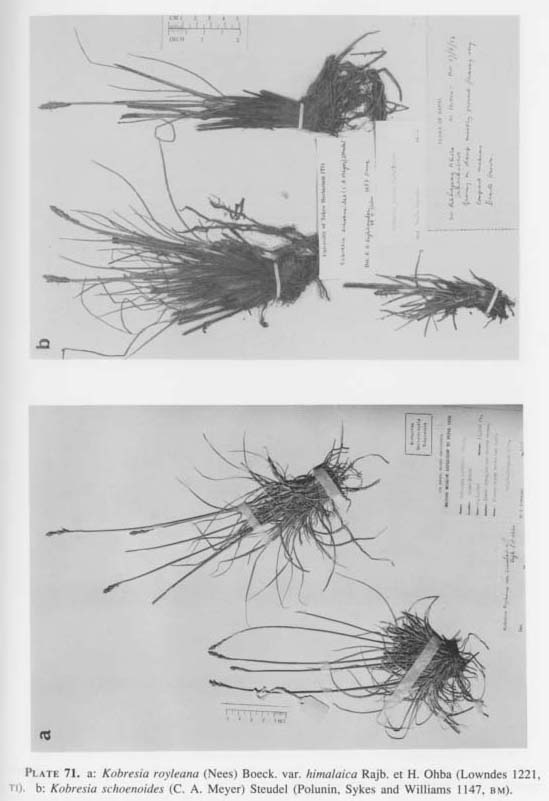
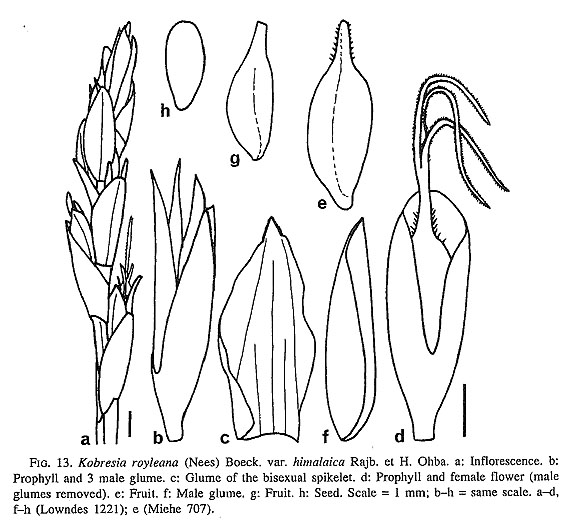
K. caricina auct. non Willd.: T. Koyama in Hara et al., Enum. Fl. Pl. Nepal 1: 113 (1978), pro parte (Lowndes 1221 cit.).
K. schoenoides auct. non (C. A. Meyer) Steudel: T. Koyama in Hara et al., Enum. Fl. Pl. Nepal 1: 114 (1978), pro parte (Polunin 256 cit.).
A typo habitu magnitudine conspicue redactiore et inflorescentia simplicique non ramificanti bene differt.
Rhizomes densely tufted, 2 mm thick. Culms 5-36 cm tall, 1 mm thick, erect, triquetrous, base covered with brown, lamina-bearing outer sheaths. Leaves up to 26 cm long; lamina linear, flat or convolute, up to 2 mm wide, surface glabrous, margin scabrid; sheaths membranous, brown; ligules minute.
Inflorescences consisting of a single spike; axis smooth. Spikes linear, 1.2-3 cm long, up to 4 mm wide, consisting of densely arranged spikelets, lowermost spikelets sometimes loosely arranged. Lower spikelets bisexual, terminal male. Bisexual spikelets 4-6 mm long, with female flower at base and upper 3-4 male. Glumes of the bisexual spikelets ovate, obtuse, 3-5 mm long, 1.8-2 mm wide, glabrous, reddish brown, 1-nerved, nerve green, margin hyaline, lower glumes aristate, arista scabrid, glumes of the lowest spikelets sometimes sheathing. Prophylls oblong, 3-4.5 mm long, 1-1.5 mm broad, membranous, smooth, yellowish brown, nerveless, 2-keeled, keels scabrid, margins open from above down to below the middle. Male glumes elliptic- lanceolate, obtuse, 3-4 mm long, 1.5-1.7 mm wide, 1-nerved, glabrous, reddish brown, margin hyaline. Stamens 3; filaments slender, 3 mm long; anthers 2 mm long. Styles 3-fid. Nutlets oblong or obovate, 2.5-3 mm long, 0.7-2.4 mm broad, trigonous, beaked, surface smooth, pale yellow.
Distr.: C Himalaya (Nepal).
Specimens examined. NEPAL: Sangda-La, 14100 ft. (Miehe no. 520, Aug. 20, 1977, BM); Sabze Khola, 13000 ft. (Lowndes no. 1221, July 20, 1950, BM-holotype, TI-isotype); Saptse Lungpa, nr. Annapurna II Base camp, 12500 ft. (Miehe no. 707, Sept. 17, 1977, BM); Kyangjin Ghyang, 13500 ft. (Polunin no. 256, June 9, 1949, BM); Kyangjin, 11500-12000 ft. (Richards no. 64, Aug. 8, 1969, BM); Gokyo, 4600 m (Dobremez no. 408, July 8, 1970. BM).
During the course of our study we found some specimens identified as Kobresia schoenoides (C. A. Meyer) Steudel or K. caricina Willd. After examining them closely we noticed that they did not belong to either of these species. The bisexual spikelets arranged in a single unbranched spike are unlike those of K. caricina, which has a many-spiked branched inflorescence. From K. schoenoides, which has a single unbranched inflorescence, as in these specimens, it differs in having bisexual spikelets with ovate glumes, the keels of the prophylls scabrid and the margins of the prophylls open to below the middle. K. schoenoides has bisexual spikelets with elliptic or elliptic-oblong glume and smooth prophylls, the margins of which open to the base. We noticed, however, that the habit, and vegetative and floral characters of these Kobresia specimens were quite similar to those of K. royleana (Nees) Boeck. and hence recognized it as var. himalaica at that species. We have not seen the type of K. royleana, but when we checked all the specimens of K. royleana available we found that the typical K. royleana has a compound inflorescence with more than one spike, even if, sometimes, the inflorescence is small and congested. Var. himalaica, therefore, seems to be a reduced and specialized state of K. royleana.
17) Kobresia schoenoides (C. A. Meyer) Steudel, Synops. Cyper. 246 (1855)-C.
B. Clarke in Hook. f., Fl. Brit. Ind. 6: 697 (1894); in Kew Bull. Additional ser.
8: 137 (1908)-Kükenthal in Engler, Pfl.-reich IV-20, Ht. 38: 35 (1909)-Ohwi in Hara, Fl. E. Himal. 2: 151 (1971)-T. Koyama in Hara et al., Enum. Fl. Pl. Nepal 1: 114 (1978), pro parte. [Plate 71b; Pigs. 14, 26]
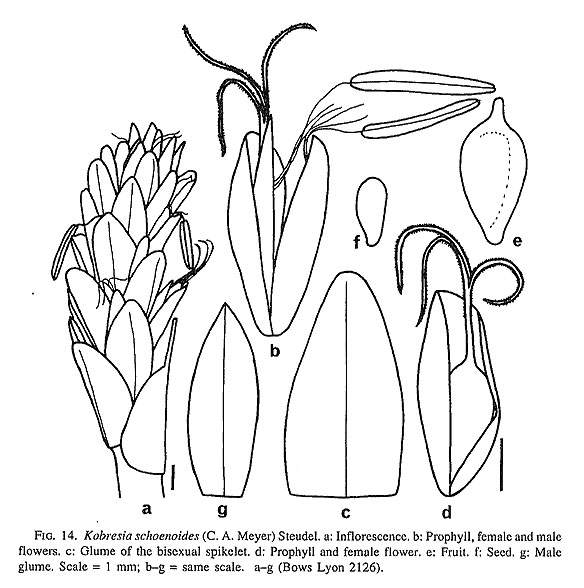
Elyna schoenoides C. A. Meyer in Ledeb., Fl. Altaica 4: 235 (1833).
Kobresia deasyi auct. non C. B. Clarke: T. Koyama in Hara et al., Enum. Fl. Pl, Nepal 1:113 (1978).
Rhizomes densely tufted. Culms stout, erect, 3-16 cm tall, 0.8-1 mm thick, striate, smooth; base covered with reddish brown, coriaceous, shining, laminaless or rarely lamina-bearing outer sheaths. Leaves 6-16 cm long; lamina linear-filiform, involute, 0.5-2 mm wide, green, surface glabrous, margin scabrous; sheaths membranous, pale brown; ligules up to 1 mm long, membranous, reddish brown.
Inflorescences erect, consisting of a single spike, axis smooth. Spikes oblong, 1-3 cm long, 3-5 mm wide, consisting of densely arranged spikelets, terminal male and others bisexual. Spikelets oblong, 3.5-4.5 mm long, 1.4-1.6 mm broad. Bisexual spikelets with a female flower at base and terminated by 2-4 male flowers. Glumes of the bisexual spikelets elliptic-oblong, apex round or obtuse, 3-4.2 mm long, 1.2-2.2 mm wide, glabrous, reddish brown, 1-nerved, nerve green; glumes of the lowest spikelets aristate or not. Prophylls oblong, 3.5-4 mm long, membranous, smooth, partly reddish brown, nerveless, margins open from above down to the base. Male glumes lanceolate, acute, 3.5-4 mm long, 1.2-1.3 mm wide, glabrous, yellowish brown, 1-nerved. Stamens 3; filaments slender, 5 mm long; anthers 1.8-2 mm long. Styles 3-fid, 1-1.5 mm long, linear. Nutlets obovoid, 2-2.5 mm long, 1.1 mm broad, slightly beaked, trigonous, smooth, yellowish brown. Seeds 1.2 mm long, obovate-elliptic, brown, apex round.
Distr.: Central Asian Highlands, Siberia and eastward to E Himalaya (Bhutan, Assam).
Specimens examined. W HIMALAYA; Pamir, 13000-14000 ft. (Alcock no. 17766, BM); Ladak, Gia to Upshi (Schlagintweit no. 1421, June 27, 1856, K); Lahul, 13000 ft. (Bor no. 15046, K); Kyelung, 15000 ft. (Bor no. 15090, TNS); Kailing-ka-jol (Bor's collector no. 20, K); Rotang Pass (Jaeschke no. 27, K); Bora Laecha La, 16000 ft. (Bor no. 13961, K); Gilgit, Nittar Valley, 11000-12000 ft. (Duthie no. 12387, K); Hazara, Kagan Valley (Ali no. 224, K); Kashmir, Musjid Valley, 13000-14000 ft. (Duthie no. 13252, K); Near Sinthan Pass, 14000 ft. (Ludlow no. 158, BM); Palgam, 13400 ft. (Clarke no. 31069, K); Rangdum Snamp Sum, 13000 ft. (Osmaston no. 27 s, K); Mt. Rolahoi (Stewart no. 9450, K); Bod Kharbu, 11500 ft. (Osmaston no. 21 s, K); Mt. Apharwat, above Gulmarg, 13000 ft. (Stewart no. 8806, K). NEPAL: Kahajeng Khola, Chharkabhot, 18000 ft, (Polunin, Sykes & Williams no. 1147, June 17, 1952, BM, TI); Sangda-La, 16800 ft. (Miehe no. 457, BM); Kyangjin Ghyang, 13500 ft. (Polunin no. 253, June 9-10, 1949, BM); Kyangjin, Langtang, 3900 m (Kanai & Shakya no. 672596, July 15, 1970, TI); Chumbu glacier (Khumbu), 15500 ft. (Bowes Lyon no. 2126, May 26, 1964, BM). SIKKIM: Sikkim (Hooker f. s.n., BM, K); Jelep La, 14000 ft. (Bor's collector no. 472); Natula, 14000 ft. (Bor's collector no. 748, K); Kapup, 13000 ft. (Bor & Kiratram no. 19814, K); Lhonak, 16000-19000 ft. (Chapman no. 154, K). BHUTAN: Chawa Gassar - Seanchu Passa, 3800 m (Kanai et al. no. 7967, May 20, 1967, TI); Chabecha - Lingshi, 3600-3900 m (Kanai et al. no. 7223, May 22, 1967, TI, KATH); Paro Chu, Tremo La, 14000 ft. (Bowes Lyon no. 3122, BM); Kantaknang, Tsampa, 13500 ft. (Ludlow, Sherriff & Hicks no. 19097, K). ASSAM: Okra La, 13000 ft. (Kmgdon-Ward no. 13775, BM). TIBET: NW of Jang La, S Tibet (N of Sikkim), 15000 ft. (Waddell s.n., K); Phari, 14600 ft. (Bor & Kiratram no. 19314, K); Hotee, 15000 ft. (Strachey & Winterbottom s.n., K); Kumali river, 15500 ft. (Strachey & Winterbottom s.n., K); Base Camp, Mount Everest, 16800 ft.(Wager no. 12, K).
Kobresia schoenoides can be distinguished from the others by the inflorescence, the rigid culms and the coriaceous, shining laminaless outer sheaths. The apex of the glume is aristate, obtuse or round. This species resembles K. nitens C. B. Clarke and K, royleana var. himalaica Rajb. et H. Ohba but can be distinguished by the oblong spikes from the former and from the latter by the elliptic glumes and smooth prophylls. K. nitens has ovate spikes and K. royleana var, himalaica has ovate glumes and the keels of the prophylls are slightly scabrid. The margins of the prophylls
of K. schoenoides are open to the base while those of K. nitens are open only to just below the apex and those of K. royleana var. himalaica are open to below the middle.
18) Kobresia seticulmis Boeck. in Linnaea 39: 3 (1875)-C. B. Clarke in Hook. f., Fl. Brit. Ind. 6: 695 (1894); in Kew Bull. Additional ser. 8: 136 (1908)-Kükenthal in Engler, Pfl.-reich IV-20, 38: 41, f. 9B (1909)-T. Koyama in Ohashi, Fl. E. Himal. 3: 128 (1975); in Hara et al., Enum. Fl. Pl. Nepal 1: 114 (1978). [Plate 72a; Figs. 8i-o, 22]
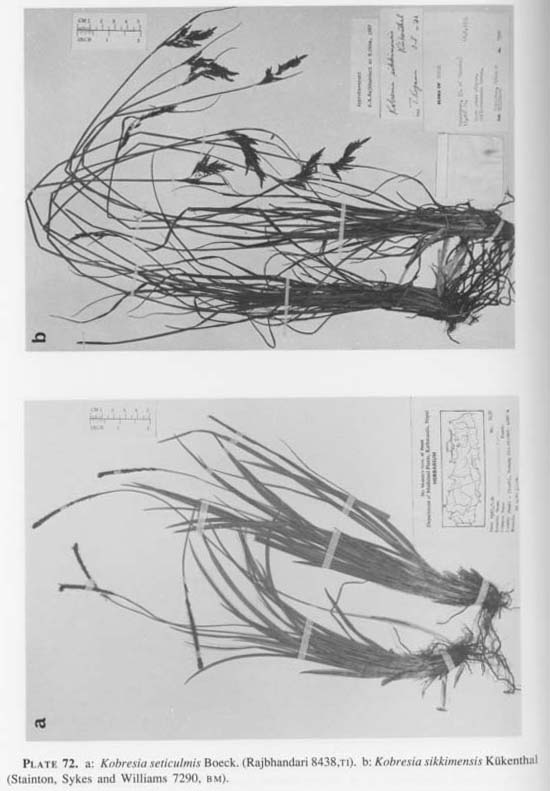

K. hookeri auct. non Boeck.: C. B. Clarke in Hook. f., Fl. Brit. Ind. 6: 695 (1894).
Rhizomes densely tufted. Culms 8-32 cm tall, 0.5-1 mm thick, slender, slightly triquetrous, smooth; base covered with brown, laminaless or lamina-bearing outer sheaths. Leaves as long as culms; lamina linear, flat, 1-4.5 mm wide, surface glabrous, margin scabrid; sheaths membranous, smooth, greenish-brown; ligules minute.
Inflorescences erect, consisting of a single spike. Spikes linear, 1.5-6.5 cm long, 2-3 mm wide, androgynous, with lower female spikelets and terminal male; axis triquetrous, smooth. Glumes of the female spikelets ovate or oblong, aristate or obtuse, 3.5-4 mm long, glabrous, reddish-brown or dark brown, 1-nerved. Prophylls oblong, obtuse or truncate, 3-4 mm long, membranous, smooth, yellowish brown or dark brown, nerveless, 2-keeled, keels scabrid, margins open from above down to the middle or up to below the middle. Sterile rachillas of the female spikelets sometimes present and up to 2.5 mm long. Male glumes oblong, obtuse or round, up to 6 mm long. glabrous, reddish brown, 1-nerved. Stamens 3; filaments slender, 5-7 mm long; anthers 2.6-3.5 mm long. Styles 1 mm long, 3-fid. Nutlets linear, beaked, 4-4.5 mm long including beak, exserted from prophyll, slightly trigonous, smooth, pale yellow, beak brown. Seeds oblanceolate, 2 mm long, 0.3 mm broad, greenish yellow.
Distr.: Himalaya (Kumaun to Bhutan), Tibet and SW China (Yunnan).
Specimens examined. NEPAL: Lete, S of Tukucha, Kali Gandaki, 10500 ft. (Stainton, Sykes & Williams no. 1031, BM); Thanti, Manang District, 4200 m (Rajbhandari no. 8438, July 26, 1983, TI, KATH); Thare, 13000 ft. (Saman & Bista no. 13185, June 15, 1965, TI); Mulkharka, Chilime Khola, 3800-4100 m (Kanai & Shakya no. 672237, July 2, 1970, TI); Thale Patil - Rock Shelter I, 3500-3270 m (Kanai & Malla no. 674760, Aug. 24, 1969, TI); Nangaon, Dolakha District, 4200 m (Rajbhandari no. 9986, Sept. 6, 1983, TI, KATH); Janakpur Zone, Ramechhap District, Serdingma - Dubikharka, 3400-3720 m (Ohba et al. no. 8570252, July 7, 1985, TI, KATH); Baula Pokhari - Chhu Ningma, 3900 m (Ohba et al. nos. 60268, 8580245, July 11, 1985, TI, KATH); Around Jata Pokhari, 4220 m (Ohba et al. nos. 8590128, 8590117, July 13, 1985, TI); Jata Pokhari - NW of Panch Pokhari, 4600 m (Suzuki, Kurosaki & Wu no. 8570493, July 16, 1985, TI, KATH); Jata Pokhari - Panch Pokhari Deurali, 4350 m (Ohba & Rajbhandari no. 60395, July 16, 1985, TI, KATH); Jata Pokhari - Botase Kharka, 4200 m (Ohba et al. nos. 60452, 8580339, July 20, 1985, TI, KATH); Around Thare Og, 4150 m (Ohba et al. no. 60775, July 27, 1985, TI, KATH); Hongu Khola, Dudh Kosi, 11800 ft. (Bowes Lyon no. 2032, June 15, 1964, BM); Tem Pokhari, 14000 ft. (Williams no. 786, Sept. 19, 1969, BM); Tamur Valley, Mewa Khola, Topke Gola, 12500 ft. (Stainton no. 298, May 15, 1956, TI). SIKKIM: Changu, 13000 ft. (Cooper no. 42, BM); Lachen, 12000 ft. (Hooker f. s.n., June 20, 1849, K); Singalelah, 11500 ft. (Clarke no. 25648, K); Lhonak, 16000-19000 ft. (Chapman no. 153, K); Tsomgo, 12000 ft. (Bor's collector no. 754, K); Jelep La, 14000 ft. (Bor's collector no. 629, K); Tukola, 12500 ft. (Bor's collector no. 603, K); Near Jhegu, 12500 ft. (Bor & Kiratram no. 19777, K); Sandakpho, 12000 ft. (Gamble no. 9521, K). BHUTAN: Shingbe, Me La, NE Bhutan, 13000 ft. (Ludlow, Sherriff & Hicks no. 20683, May 31, 1949, BM); Laya, upper Mo Chu, 14000 ft. (Ludlow, Sherriff & Hicks no. 16447, June 7, 1949, BM, K, TI). TIBET: Lusha Chu, SE Tibet, 12500 ft. (Ludlow, Sherriff & Taylor no. 4727, BM); Rongshar Valley, 9500 ft. (Hingston no. 186, K); Gautso, 12500 ft. (Bor & Kiratram no. 19339, K).
Kobresia seticulmis, which resembles K. trinervis Bock., and from which it is distinguished by the androgynous spike, is commonly found in the alpine region, especially in moist areas such as on moist slopes, mossy ground or rocks.
19) Kobresia sikkimensis Kükenthal in Engler, Pfl.-reich IV-20, 38: 47 (1909)-T. Koyama in Hara et al., Enum. Fl. Pl. Nepal 1: 114 (1978). [Plate 72b; Figs. 15, 24]
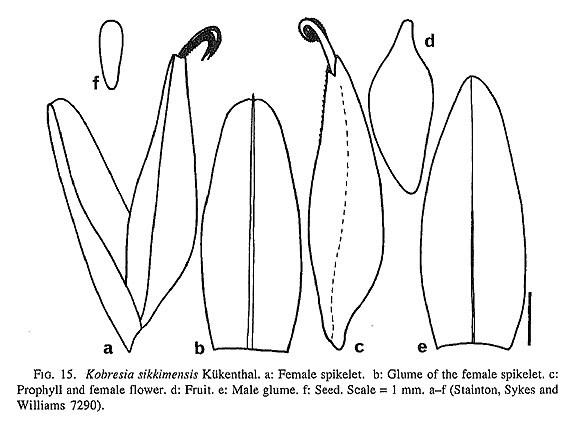
Carex prainii Kükenthal in Bull. Herb. Boiss., ser. 2, 4: 51 (1903)-C. B. Clarke in Kew Bull. Additional ser. 8: 145 (1908).
Rhizomes tufted, 2.5-3 mm thick. Culms 40-60 cm tall, erect, triquetrous, smooth; base covered with membranous, yellowishbrown, laminaless outer sheaths. Leaves
up to 32 cm long; lamina linear, flat, 2-3 mm wide, surface glabrous, margin scabrid; sheaths membranous, smooth, greenish-yellow; ligules minute, hyaline.
Inflorescences oblong, 4-6 cm long, 0.5-1.5 cm wide, with loosely arranged spikes. Glumes of the lowest spikes leafy, longer than the inflorescence, linear, 4 - 10 cm long, 2 mm wide, green, glabrous, margin scabrid; glumes of the upper spikes aristate. Spikes linear, androgynous, 1.5-3 cm long, 3-5 mm broad, with unisexual spikelets, lower spikelets female and terminal male. Female spikelets 5.5-6 mm long, 2 mm broad. Glumes of female spikelets oblong, 4.5-4.8 mm long, 1.7-2 mm wide, mucronate, glabrous, yellowish brown, margin hyaline, 1-nerved. Prophylls elliptic, 5-6 mm long, 1.2-1.4 mm broad, membranous, smooth, reddish brown, 2-keeled, keels slightly scabrid on the upper part, margins open from above down to below the apex. Sterile rachillas of the female spikelets up to 2.5 mm long, included in the prophyll, flat, green, margin scabrous, rarely absent. Male glumes oblong, obtuse, 4.5-6 mm long, 1.5-2 mm wide, glabrous, yellowish brown, margin hyaline, 1-nerved. Stamens 3; filaments slender, 4-5 mm long; anthers 4.8-5.2 mm long. Styles 3-fid, 1 mm long. Nutlets elliptic, trigonous, slightly beaked, 3.2-3.4 mm long including beak, 1.2 mm broad, smooth, yellowish brown. Seeds oblong-oblanceo-late, obtuse, 1.3 mm long, 0.4 mm broad, brown or greenish yellow.
Distr.: Himalaya (Nepal and Sikkim).
Specimen examined: NEPAL: Samargaon, N. of Tukucha, 15000 ft. (Stainton, Sykes and Williams no. 7290, Aug. 16, 1954, BM).
Kobresia sikkimensis seems to be rare in Nepal. It was described by Kükenthal (1903) from a specimen collected in Sikkim by King's native collector. We have not seen the type, but the specimen described here is quite similar to the descriptions of K. sikkimensis given by Kükenthal, we therefore considered it to be K. sikkimensis. The species is characterized by an inflorescence with loosely arranged linear spikes and unisexual spikelets. The habit of the plant is similar to that of K. laxa but the prophyll is distinctly elliptic in this species and the rachilla is included in the prophyll, whereas in K. laxa the prophyll is linear and the rachilla is as long as or exserted from the prophyll.
20) Kobresia trinervis (Nees) Boeck. in Linnaea 39: 4 (1875), in note-C. B. Clarke in Hook. f., Fl. Brit. Ind. 6: 695 (1894); in Kew Bull. Additional ser. 8: 137 (1908)-Kükenthal in Engler, Pfl.-reich IV-20, 38: 43, t.10 (1909)-T. Koyama in Ohashi, Fl. E. Himal. 3: 129 (1975); in Hara et al., Enum. Fl. Pl. Nepal 1: 114 (1978). [Plate 73a; Figs. 9h-n, 29]
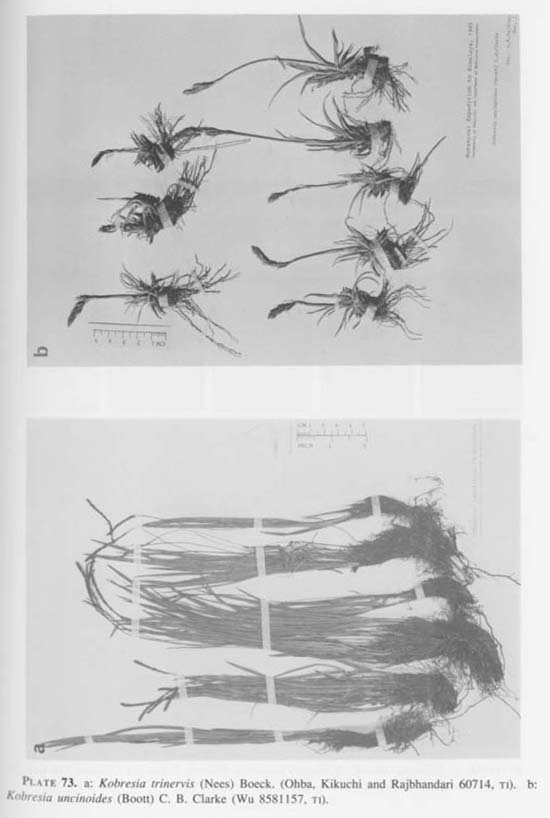

Carex trinervis Nees in Wight, Contrib. Bot. Ind. 120 (1834); non Degland (1807).
Kobresia foliosa C. B. Clarke in Hook. f., Fl. Brit. Ind. 6: 696 (1894).
K. Hookeri var. β. dioica C. B. Clarke in Hook. f., Fl. Brit. Ind. 6: 695 (1894).
K. trinervis var. foliosa (C. B. Clarke) Kükenthal in Engler, Pfl.-reich IV-20, 38: 43, t. 10 (1909).
Rhizomes densely tufted. Culms slender, 8-26 cm tall, 0.8 mm thick, triquetrous, smooth; base covered with dark brown, lamina-bearing or laminaless outer sheaths. Leaves shorter than or as long as culms; lamina linear, flat, 1.5-5 mm wide, surface glabrous, margin scabrid; sheaths membranous, pale brown; ligules minute, pale brown.
Inflorescences erect, unisexual, consisting of a single spike. Spikes linear; the female 3.5-6.5 cm long, 1.5-2.5 mm wide; the male 2.5-6 cm long, 2-5 mm wide; axes triquetrous, smooth. Glumes of the female spikelets ovate, aristate, 3.5-4 mm long excluding arista, glabrous, reddish brown, 1-nerved, arista scabrid, upper glumes sometimes ovate-oblong. Prophylls linear, 3-4 mm long, membranous, smooth, greenish brown or brown, nerveless, keels scabrid, margins open from above down to the middle. Male glumes oblong, apex round, 7 mm long, 2 mm wide, glabrous, reddish brown, apical margin thinly hyaline, 1-nerved. Stamens 3; filaments slender, 8-10 mm long; anthers 4.5 mm long. Styles 3-fid, 1-2.5 mm long. Nutlets elliptic, beaked, 3-4.5 mm long including beak, included in prophyll or slightly exserted, smooth, pale yellow, beak brown. Seeds oblanceolate, obtuse, 1.8 mm long, 0.5 mm broad, greenish yellow.
Distr.: Himalaya (Punjab to Bhutan), Tibet, SW China (Yunnan).
Specimens examined. W HIMALAYA: Punjab, Kunawar (Drummond no. 22437, K); Bassahir - Kunawar (Drummond no. 22446, K); Garhwal, Pathar Koree, 11000 ft. (Strachey & Win-terbottom no. 19, K, BM); Hemkund, 4000 m (Bhattacharya no. 39030, June 19, 1969, TI); Ridge above Iliala, Tihri-Garhwal, 11000-12000 ft. (Duthie no. 57, K-syntype of K. foliosa C. B. Clarke, BM-isosyntype); Near Bhoniani, 13000-14000 ft. (Duthie no. 4494, BM-isosyntype of K. foliosa C. B. Clarke); Kedarkanta, 12000 ft. (Gamble s.n., K); Kumaun, Palang Gadh, Byans, 10000-12000 ft. (Duthie no. 6092, July 21, 1886, BM). NEPAL: Jangia Banjang, 3800-3900 m (Einarsson, Skarby & Wetterhall no. 3546- 3547, Aug. 18, 1973, BM); Babaria Lekh, 13500 ft. (Polunin, Sykes & Williams no. 71, July 8, 1952, TI); Sauwala Khola, 11500 ft. (Stainton, Sykes & Williams no. 2957, June 3, 1954, BM, TI); East of Chalike Pahar, 14500 ft. (Stainton, Sykes & Williams no. 3747, Aug. 4, 1954, BM, TI); Near Pudamigaon, near Suli Gad, 12000 ft. (Polunin, Sykes & Williams no. 2235, June 17, 1952, K); South of Gurjakhani, 11800 ft. (Stainton, Sykes & Williams no. 3056, June 7, 1954, TI); Lete, S of Tukucha, Kali Gandaki, 10500 ft. (Stainton, Sykes & Williams nos. 978, 982, June 6, 1954, TI); Rambrong, Lamjung Himal, 14000 ft. (Stainton, Sykes & Williams no. 6156, July 5, 1954, BM, TI); Langtang, Rasua District, 3300 m (Rajbhandari, Sharma & Kayastha no. 10612, May 17, 1985, TI, KATH); Langtang valley, 13000 ft. (Schilling, Sayers & Bista no. 446, June 21, 1965, K); Mulkharka, Chilime Khola, 3800-4100 m (Kanai & Shakya no. 672322, July 6, 1970, TI); Janakpur Zone, Ramechhap Distr., Jata Pokhari - Botase Kharka, 4220-4500 m (Ohba et al. nos. 60449, 60450, and 8580338, July 20, 1985, TI, KATH); Botase Kharka - Koshing Kharka, 4500-4000 m (Ohba et al. no. 8570623, July 21, 1985, TI, KATH); Jata Pokhari - ridge between Khimti Khola east and west, 4220-4650 m (Ohba, Wakabayashi & Wu no. 8530333, TI, KATH); Around Jata Pokhari, 4220 m (Ohba et al. no. 8590188, July 18, 1985, TI, KATH); Thare Og - Bigphera Lho Glacier, 4600 m (Ohba, Kikuchi & Rajbhandari no. 60714, July 25, 1985, TI, KATH); Sagarmatha Zone, Solukhumbu District, Beni Kharka - Yuri Golcha, 3970-4500 m (Wu no. 8581131, Aug. 23, 1985, TI, KATH). Sikkim: Namdee, 12000 ft. (Pantling no. 46568, K-holotype of K. hookeri var. β. dioica C. B. Clarke).
Kobresia trinervis resembles K. seticulmis Boeck. But they differ in the spike and insertion of nutlet. The spike is unisexual in K. trinervis while it is androgynous in K. seticulmis. The nutlet is exserted from the prophyll in K. seticulmis and included in K. trinervis, but sometimes, especially in profuse, tall leafy individuals of K. trinervis it is exserted. Moreover, the habitat of these two species seems to be
different. On a trip to central Nepal in 1985, we noticed that K. seticulmis commonly occurs in moist places especially on mossy rocks, but K. trinervis prefers drier slopes. In the specimen, Ohba et al. no. 8570623, a sterile rachilla about 4 mm long is present and in some parts of the spike two glumes are fused together, which are unusual in this species. This species approaches K. mallae Rajb. & H. Ohba in habit, but the prophyll structure is quite different in these two species.
21) Kobresia uncinoides (Boott) C. B. Clarke in Hook. f., Fl. Brit. Ind. 6: 698 (1894); in J. Linn. Soc. Bot. 36: 269 (1903); in Kew Bull. Additional ser. 8: 137 (1908)-Kükenthal in Engler, Pfl.-reich IV-20, 38: 46 (1909)-T. Koyama in Ohashi, Fl. E. Himal. 3: 129 (1975); in Hara et al., Enum. Fl. Pl. Nepal 1: 114 (1978). [Plate 73b; Figs. 16, 30]

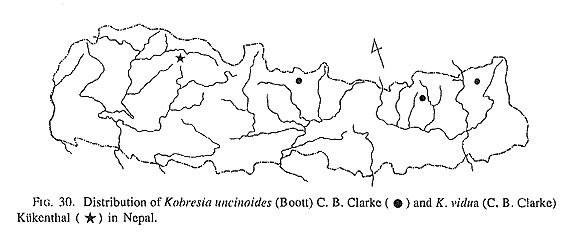
Carex uncinoides Boott, Illustr. Carex 1: 8, t. 23 (1858)-C. B. Clarke in Journ. Linn. Soc. Bot. 20: t. 30, f. 1-2 (1883).
Kobresia royleana auct. non (Nees) Boeck.: T. Koyama in Hara Fl. E. Himal. 392 (1966).
Rhizomes tufted, 4 mm thick, covered with membranous scales. Culms erect, 1.5-35 cm tall, about 1 mm thick, striate, smooth; base covered with pale yellow, lamina-bearing outer sheaths. Leaves 1-21 cm long; lamina linear, flat, 2-4 mm wide, surface glabrous, margin scabrid; sheaths membranous, pale yellow; ligules minute, membranous, pale yellow.
Inflorescences erect, oblong, 1-7 cm long, up to 1 cm wide, with closely arranged spikes, lower spikes sometimes interrupted; axis smooth or minutely scabrid. Spikes unisexual or androgynous, oblong, 1-3 cm long, 2.5-3.5 mm wide. Spikelets unisexual. Glumes of the female spikelets oblong or ovate, subacute or obtuse, 5-6 mm long, 2.5 mm wide, glabrous, brown, 1-nerved, nerve green, minutely scabrid; lower glumes aristate. Prophylls linear-lanceolate, 6-8.5 mm long, membranous, surface minutely ciliate, pale green, nerveless, 2-keeled, keels scabrid, margins open from above down to just below the apex. Sterile rachillas of the female spikelets up to 9 mm long, flat, green, margin ciliate, exserted from prophyll. Male glumes elliptic-lanceolate, obtuse, minutely aristate, 4.5 mm long, 1.5 mm wide, membranous, glabrous, pale green, 1-nerved. Stamens 3; filaments 6 mm long, slender; anthers 2 mm long. Styles 3-fid, 2 mm long. Nutlets oblong or oblanceolate, slightly beaked, 3-4 mm long including beak, trigonous, smooth, yellowish green, base attenuate. Seeds oblong, 2 mm long, 0.5 mm broad, yellowish brown, apex round.
Distr.: E Himalaya (Nepal to Bhutan, Assam), Tibet and SW China (Yunnan).
Specimens examined. NEPAL: Rambrong, Lamjung Himal, 11500 ft. (Stainton, Sykes & Williams no. 6004, June 29, 1954, BM, TI); Annapurna Himal, Seti Khola, 12500 ft. (Stainton, Sykes & Williams no. 6627, Aug. 3, 1954, TI); Sagarmatha Zone, Solukhumbu Distr., Beni Kharka (Dambuk) - Lum Teng, 3970-4600 m (Wu no. 8581157, Aug. 24, 1985, TI, KATH); Arun Valley. Thudam, E of Chyamtang, 12500 ft. (Stainton no. 374, May 21, 1956, BM, TI); Topke Gola, 3800 m (Kanai et al. no. 720578, June 18, 1972, TI); Chairam, 13500 ft. (Williams no. 859, June 23, 1969, TI). SIKKIM: Jongri, 13000 ft. (Clarke no. 25999, BM); loc. cit., alt. 4000 m (Hara et al. no. 2708, May 22, 1960, TI); Chakung Chu, 14000 ft. (Cooper no. 928, BM); Sikkim, 11-14000 ft. (Hooker f. s.n,, K, BM); Yakla, 12000 ft. (Clarke no. 9989, K); Jongri, 12000 ft. (Clarke no. 25950, K); Jelepla, 14000 ft., (Bor's collector no. 614, K); Kopup, 13000 ft. (Bor's collector no. 602, K); Tsomgo, 12000 ft. (Bor's collector no. 986, K); Natula, 14000 ft. (Bor's collector no. 1037, K); Shervathang, 13000 ft. (Cooper no. 141, BM). BHUTAN: Phajudin Timpa, 10000 ft. (Cooper no. 2916, BM). ASSAM: Okra La, 12000 ft. (Kingdon-Ward no. 13779, BM), TIBET: Tsari Valley, Chickchar Valley, Southern Tibet, 12000 ft. (Kingdon-Ward no. 11876, BM).
Kobresia uncinoides resembles K. curvata Kükenthal and K. fragilis C. B. Clarke in having unisexual spikelets and prominent sterile rachillas, but in both these species conspicuous long leafy glumes are present in the lowest spikes while in K. uncinoides the inflorescence is congested and conspicuously bladed leafy glumes are not found. The surface of the prophyll in K. uncinoides is hairy while it is glabrous in these species. Hairy prophylls are also found in K. curticeps (C. B. Clarke) Kükenthal, but in the female spikelets of K. curticeps conspicuous rachillas are absent.
22) Kobresia vidua (C. B. Clarke) Kükenthal in Engler, Pfl.-reich IV-20, 38: 40 (1909)-T. Koyama in Hara et al., Enum. Fl. Pl. Nepal 1: 114 (1978). [Plate 74a; Figs. 11h-m, 30]
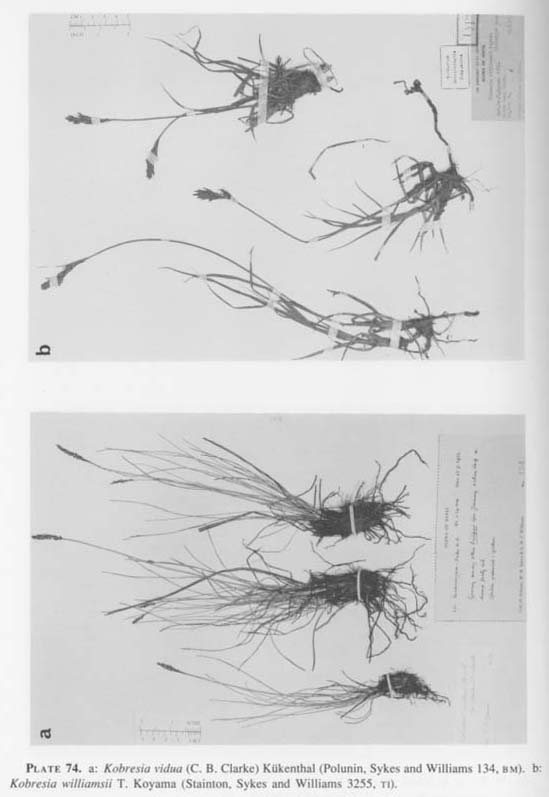
Carex vidua Boott ex C. B. Clarke in Hook. f., Fl. Brit. Ind. 6: 713 (1894); in Kew Bull. Additional ser. 8: 143 (1908).
Rhizomes densely tufted. Culms 14-20 cm tall, 1 mm thick, striated, smooth; base covered with chestnut-brown laminaless sheaths. Leaves equalling or shorter than culms, up to 18 cm long; lamina linear, 0.4-1 mm wide, convolute, setaceous, margin scabrid; sheaths membranous, pale brown; ligules minute, membranous, pale brown.
Inflorescences dioecious, consisting of a single spike. Female spikes linear, 2-2.5 cm long, 3-4 mm wide; axis smooth. Female spikelets ovate, 3-3.5 mm long, 1-2 mm broad. Glumes of the female spikelets ovate, obtuse, 3-3.8 mm long, 1.6-2 mm wide, glabrous, chestnut-brown, 1-nerved. Prophylls elliptic-oblong, 2.2-2.5 mm long, 1-1.4 mm broad, membranous, smooth, pale yellowish brown or reddish brown, nerveless, margins open from above down to below the apex. Sterile rachillas of the female spikelets up to 1.5 mm long, glabrous, green. Styles 3-fid. Nutlets oblong, beaked, 2.7-3 mm long including beak, 1-1.3 mm broad, slightly trigonous, smooth.
Distr.: Himalaya (Nepal, Sikkim).
Specimen examined. NEPAL: Maharigaon, 3 miles NE, ca 14500 ft. (Polunin, Sykes & Williams no. 134, July 13, 1952, BM, TI).
Kobresia vidua is a rare species in the Himalaya. As noted by Koyama (1978) this species is known only from two collections, Hooker's collection at Lachen, Sikkim, and the present one. We have not seen the type of this species. The size of the prophyll and smoothness of the keel in the specimen examined are different from the descriptions given by Clarke (1894) and Kükenthal (1909) for K. vidua, but other characters agree with the description. The prophyll of K. vidua was described by Clarke (1894) and Kükenthal (1909) as 4 mm long and with a scabrid keel, but in the specimen we examined it only reaches 2.5 mm in length and its keels are smooth.
Kobresia vidua resembles the dioecious form of K. nepalensis (Nees) Kükenthal, but can be distinguished from it by the elliptic-oblong, 2.2-2.5 mm long, prophyll. In K. nepalensis the prophyll is linear-oblong and 4-7 mm long.
23) Kobresia williamsii T. Koyama in Bot. Mag. Tokyo 86: 279, t. 3 (1973); in Ohashi, Fl. E. Himal. 3: 129 (1975); in Hara et al., Enum. Fl. Pl. Nepal 1: 114 (1978). [Plate 74b; Pigs. 17, 18]


Rhizomes elongated, 1-2 mm thick, covered with brown scales. Culms erect, up to 32 cm tall, 1 mm thick, triquetrous, smooth; base covered with pale yellow, lamina-bearing outer sheaths. Leaves shorter than culms; lamina linear, flat, 3 mm wide, apex subulate, surface glabrous, margin scabrous; sheaths membranous, smooth, pale yellow; ligules minute, membranous, smooth, pale yellow.
Inflorescences erect, oblong or elliptic-oblong, up to 8 cm long, 1 cm wide, with loosely arranged or congested spikes; axis triquetrous, smooth. Spikes loosely arranged or congested, elliptic or oblong, up to 2 cm long, 3-4 mm broad. Spikelets bisexual, terminal male, sometimes male flower reduced in some of the lateral bisexual spikelets and becoming female, lowest spikelet female. Glumes of the lowest spikes sheathing or not, shorter than inflorescence, ovate, aristate, 5-7 mm long excluding arista, glabrous, 5-7-nerved, middle part with nerves green, marginal part hyaline, brown, arista scabrid. Glumes of bisexual spikelets ovate-oblong or elliptic-oblong, rotundate-truncate, 3.5-6 mm long, glabrous, 1-3-nerved. Prophylls linear or oblong-lanceolate, 6.5-8 mm long, membranous, smooth, pale green, partly brown, 2-nerved, margins open from above down to just below the apex. Rhachillas between female and male flowers about 3 mm long, flat, green, glabrous, 1-nerved. Male glumes elliptic, 6 mm long, glabrous, partly reddish brown, 1-nerved. Stamens 3; filaments slender, 8 mm long. Styles 3-fid, 1-1.5 mm long. Nutlets obovoid, trigonous, 3-3.8 mm long, smooth, yellowish green. Seeds obovate, obtuse, trigonous, 2.5-3.3 mm long, 1-1.2 mm broad, greenish yellow.
Distr.: C Himalaya (Nepal), Tibet.
Specimens examined. NEPAL: Above Seng Khola, 13000 ft. (Stainton, Sykes & Williams no. 3255, June 26, 1954, BM-holotype, TI); Janakpur Zone, Ramechhap Distr., Baula Pokhari - Chhu Ningma, 3960-4040 m (Ohba et al. nos. 8580244 and 8570369, July 11, 1985, TI, KATH); Dubikharka - Baula Pokhari, 3720-3960 m (Ohba et al. no. 8570312, July 9, 1985, TI, KATH); Botase Kharka - Koshing Kharka, 4500-4000 m (Ohba et al. nos. 60478 and 8580353, July 21,1985, TI, KATH); Koshing Kharka-Thare Og, 3800 m (Ohba et al. no. 60519, July 22, 1985, TI, KATH); Thudam - Lama Chungbu, 3600 m (Kanai et al. no. 720681, June 23, 1972, TI).
Kobresia williamsii resembles K. curticeps (C. B. Clarke) Kükenthal from which it is distinguished by the glabrous prophylls; the prophylls are hairy in K. curticeps. This species also resembles K. harae Rajb. & H. Ohba but the size of the inflorescence and prophyll separate them.
Acknowledgements
We are grateful to Drs. Samar B. Malla and Saman B. Rajbhandari of the Department of Forestry and Plant Research, H.M.G. Nepal, for encouragement and use of facilities. Thanks are due to the Directors and Curators of the herbaria BM, K, LIV and TNS for the loan of specimens.
References
- Blaser, H. W. 1944.
- Studies in the morphology of the Cyperaceae II. The prophyll. Amer.
J. Bot. 31: 53-64.
- Boeckler, 0. 1875.
- Die Cyperaceen. Linnaea 38: 1-152.
- Clarke, C. B. 1883.
- On Hemicarex and its allies. J. Linn. Soc. Bot. 20: 374-403.
- ———. 1894.
- Cyperaceae. In: Hooker, J. D. Flora of British India 6: 585-748.
- ———. 1903.
- Cyperaceae. J. Linn. Soc. Bot. 36: 202-319.
- ———. 1908.
- New genera and species of Cyperaceae. Kew Bull. Misc. Inform. Additional ser. 8: 1-196.
- Dahlgren, R. M. T., Clifford, H. T., and P. F. Yeo. 1985.
- The Families of the Monocotyledons. Springer-Veriag, Berlin.
- Kern, J. H. 1974.
- Cyperaceae. In: Flora Malesiana, Ser. I, Vol. 7: 435-753.
- Koyama, T. 1961.
- Classification of the family Cyperaceae (1). J. Fac. Sci. Univ. Tokyo Sect. III, Bot. 8: 37-148.
- ———. 1966.
- Cyperaceae. In: Hara, H. (compiled.), Flora of Eastern Himalaya. pp. 380-393. University of Tokyo Press, Tokyo.
- ———. 1973.
- New Cyperaceae from Nepal and adjoining Tibet. Bot. Mag. Tokyo 86: 275-283.
- ———. 1975.
- Cyperaceae. In: Ohashi, H. (compiled.), Flora of Eastern Himalaya, third report, pp. 122-129. University of Tokyo Press, Tokyo.
- ———. 1978.
- Cyperaceae. In: Hara,. H. et al., An Enumeration of the Flowering Plants of Nepal Vol. 1. pp. 96-120. British Museum (Natural History), London.
- Kükenthal, G. 1903.
- Cariceae novae vel minus cognitae. Bull. Herb. Boiss. 2, 4: 49-60.
- ———. 1909.
- Cobresia. In: Engler, A., Pflanzenreich IV-20, Ht. 38: 33-50.
- Malla, S. B. et al. (ed.). 1976a.
- Flora of Langtang. Bull. Dept. Med. Plants Nepal No. 6.
- ———. 1976b.
- Catalogue of Nepalese vascular plants. Bull. Dept. Med. Plants Nepal No. 7.
- Ohwi, J. 1971.
- Cyperaceae. In: Hara, H. (ed.). Flora of Eastern Himalaya, second report. pp. 146-151. University of Tokyo Press, Tokyo.
- Ohwi, J. and T. Koyama. 1955.
- Cyperaceae. In: Kihara, H. (ed.). Fauna and Flora of Nepal Himalaya, Vol. 1., pp. 86-90. Kyoto.
- Rajbhandari, K. R. and H. Ohba. 1987a.
- A new species of Kobresia from Nepal. J. Jap. Bot. 62: 193-197.
- ———. 1987b.
- Two new Himalayan species of Kobresia sect. Hemicarex (Cyperaceae). J. Jap. Bot. 62: 268-273.
- ———. 1988.
- Epidermal microstructures of the leaf, prophyll and nut in the Himalayan species of Kobresia (Cyperaceae). Bot. Mag. Tokyo 101: 185-202.
- Willis, J. C. 1973.
- A dictionary of the Flowering Plants and Ferns. 8th edition. Cambridge University Press, Cambridge.











































